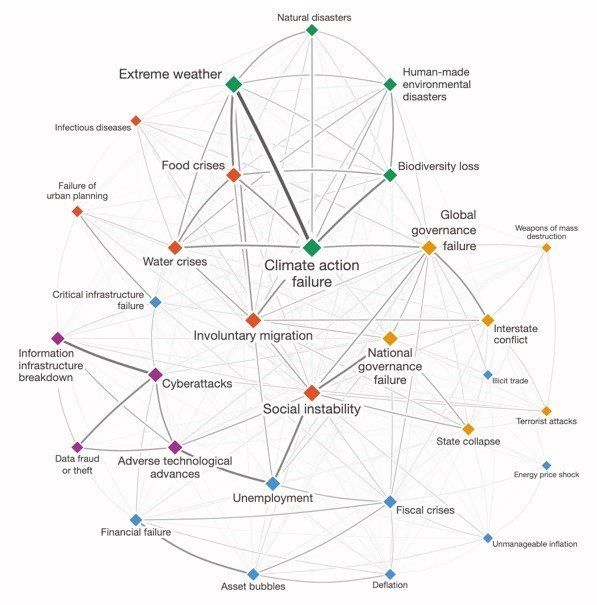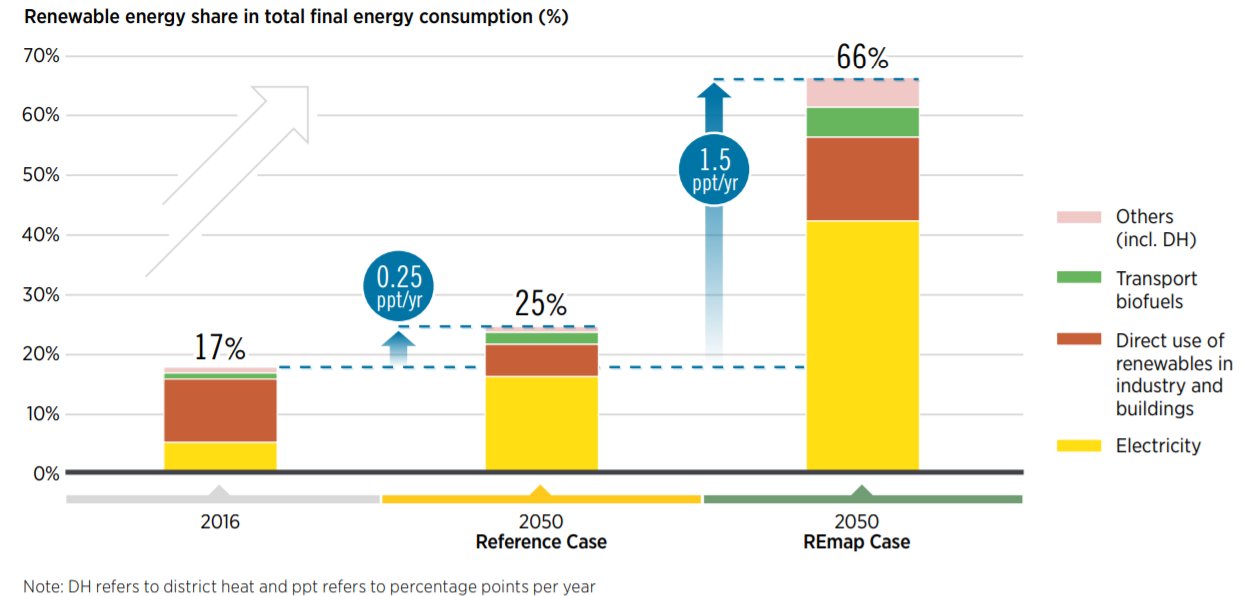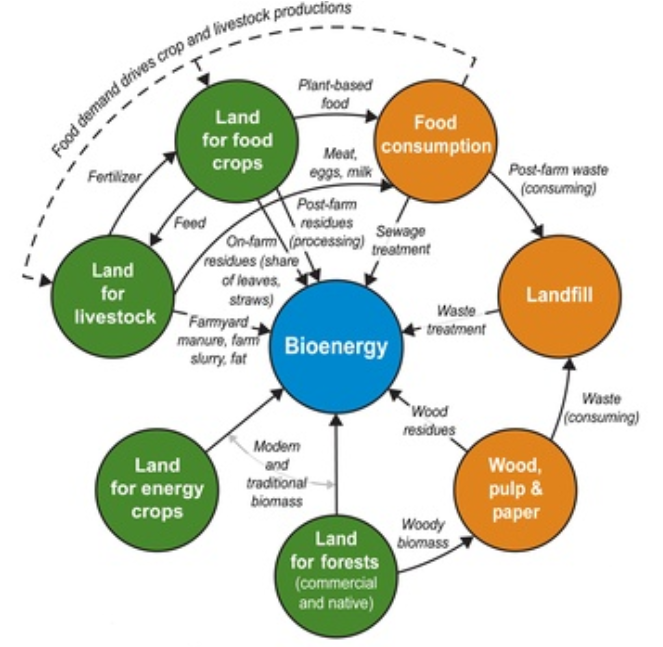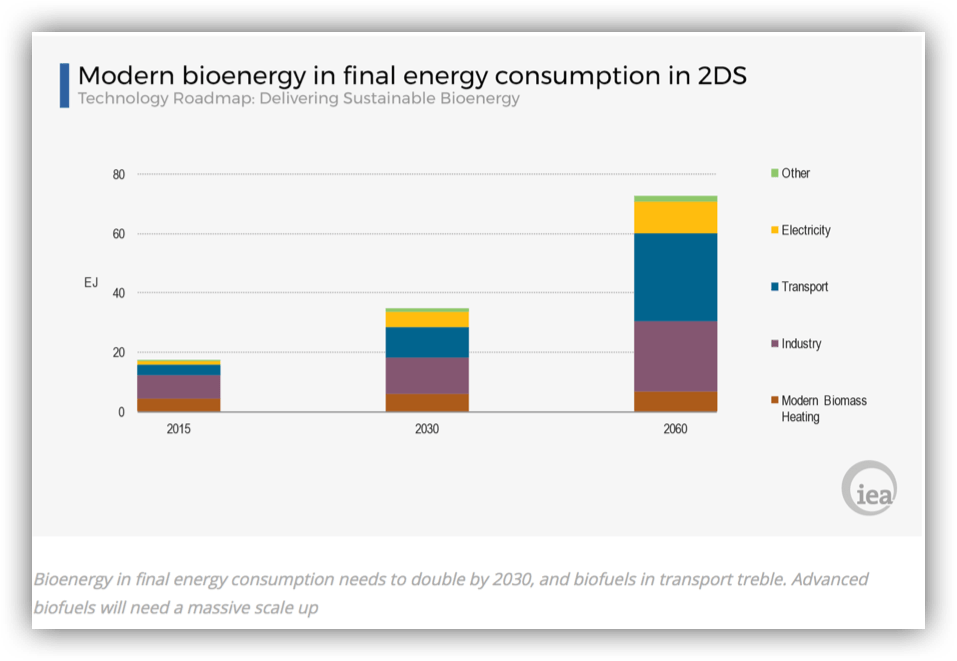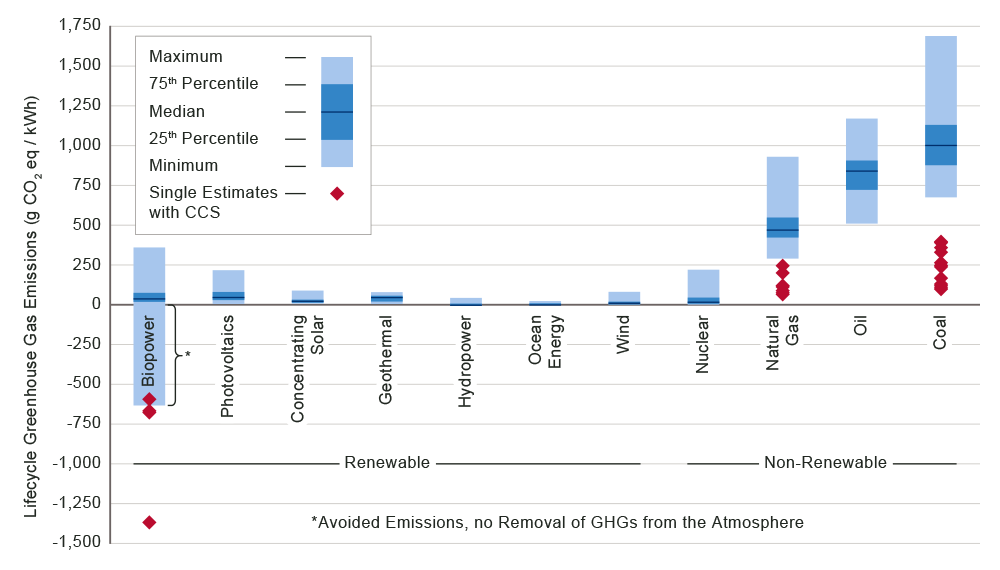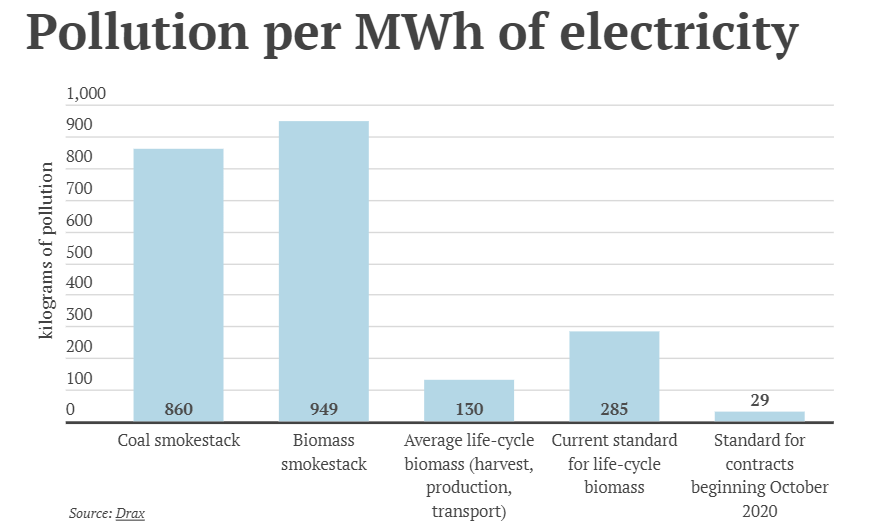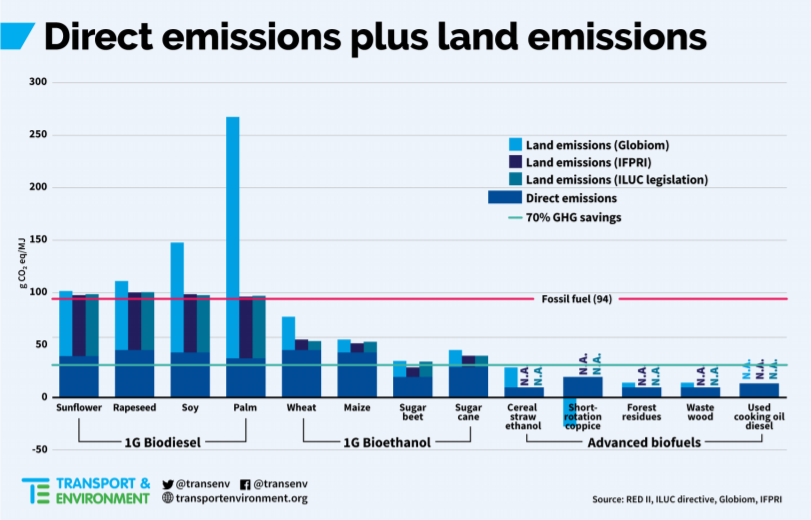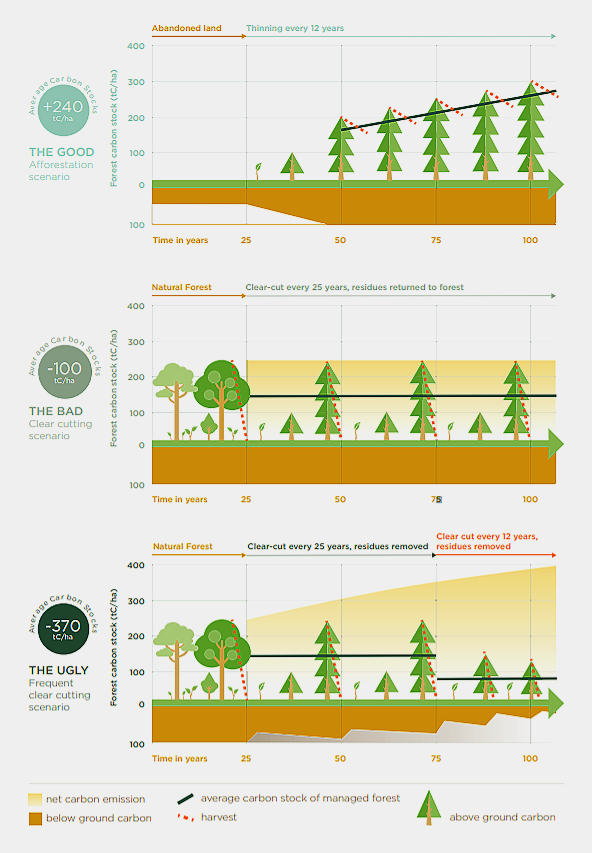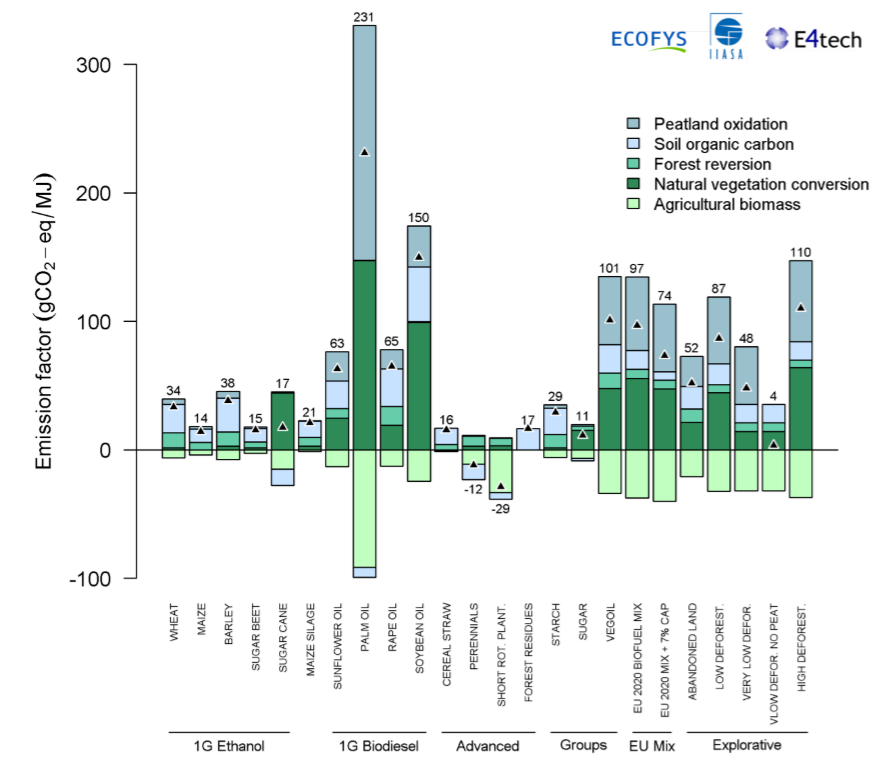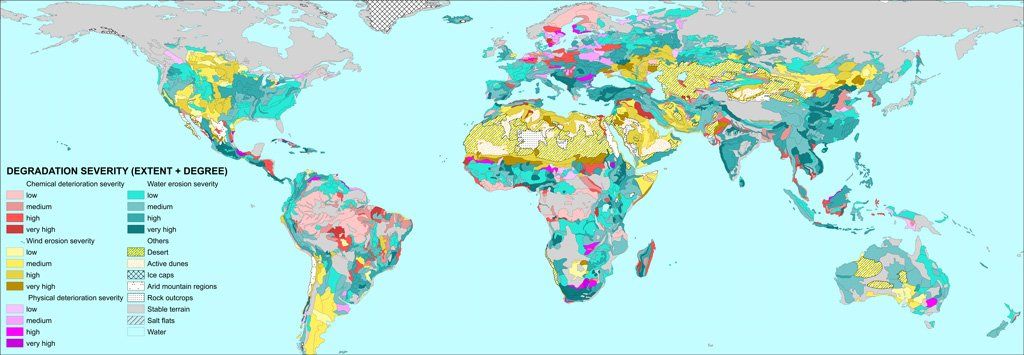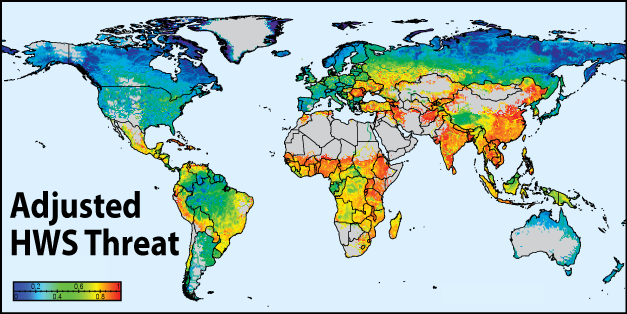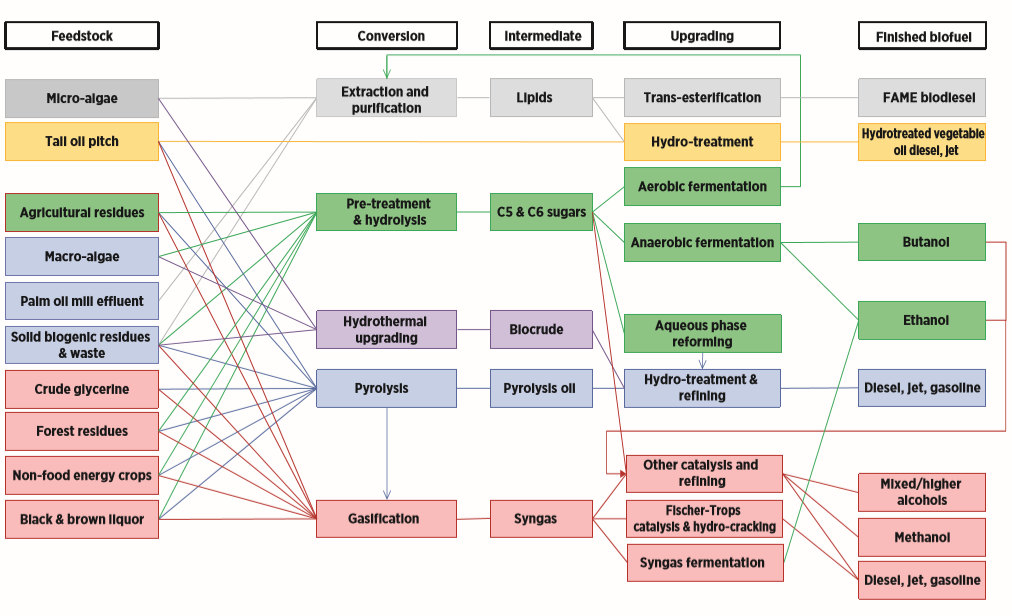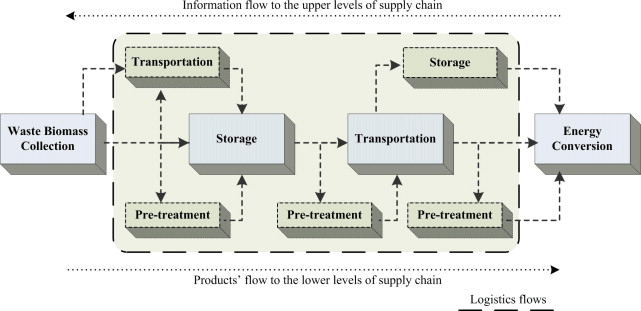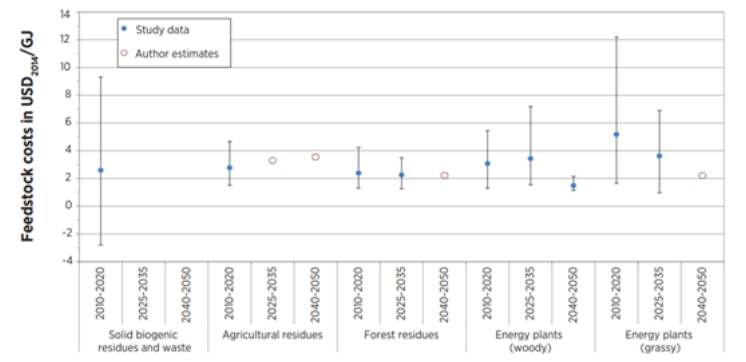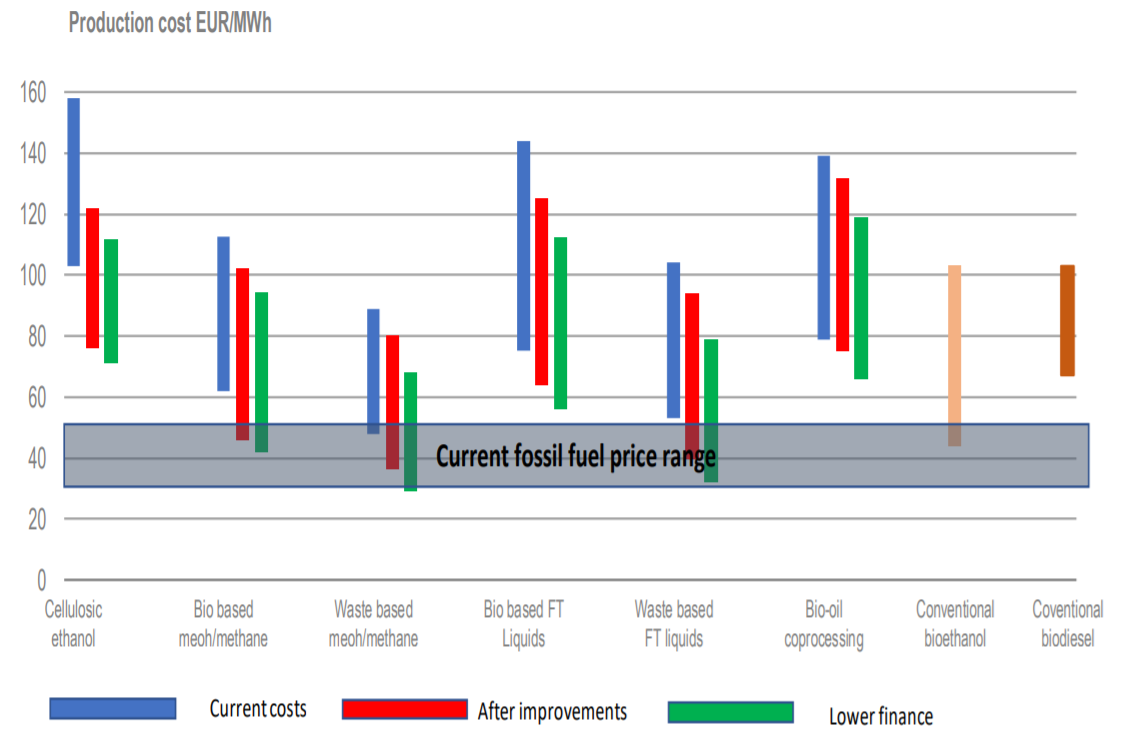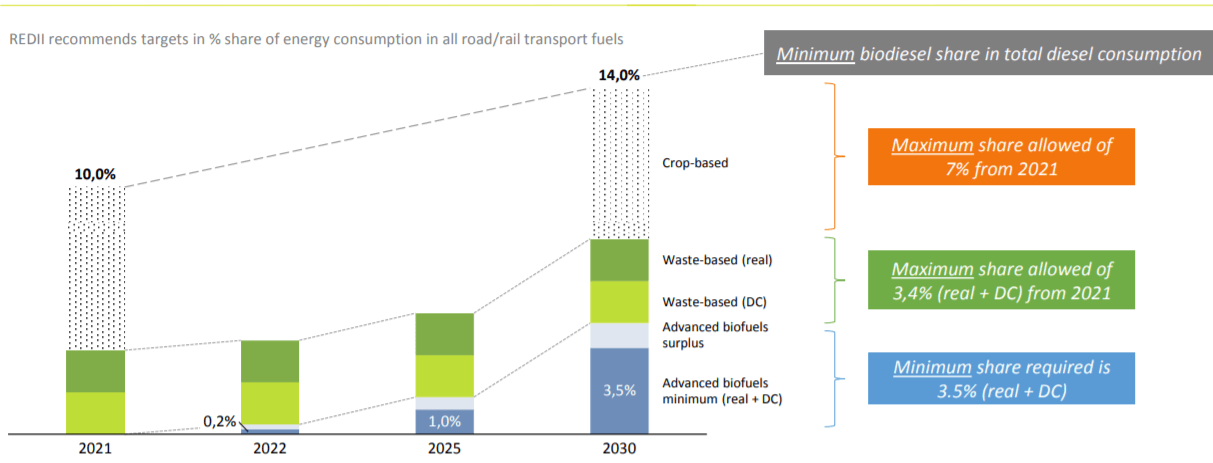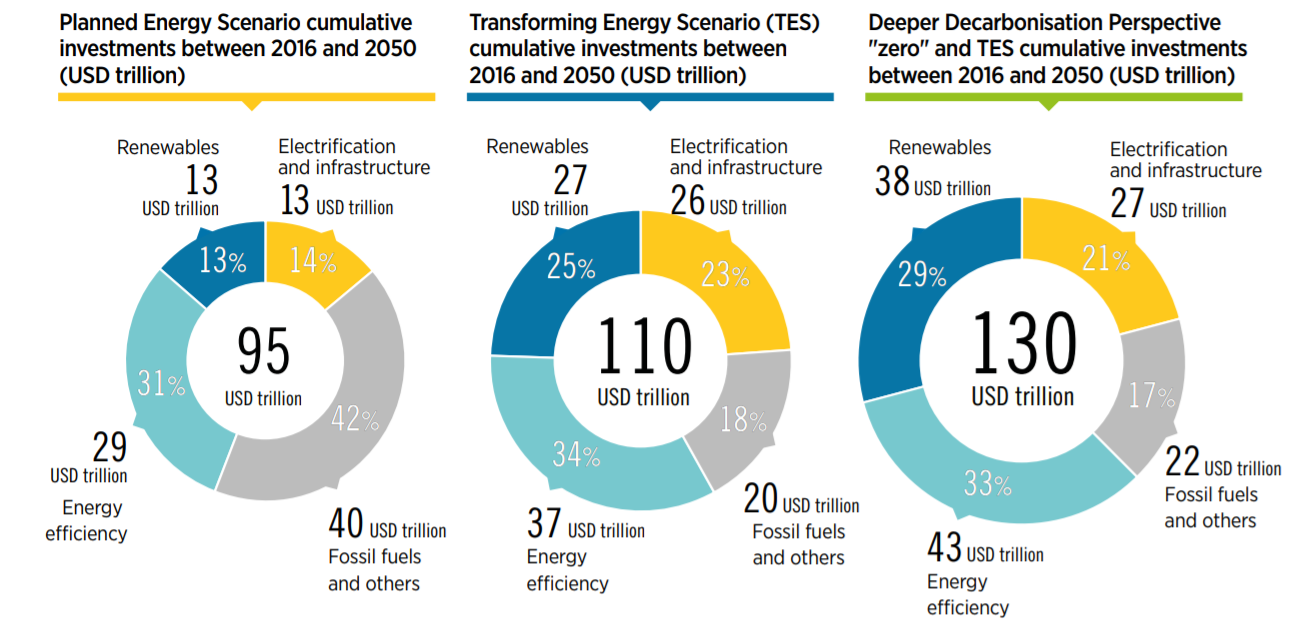Energy Transition
ENERGY TRANSITION
Summary
The Energy TransitionClimate change presents perhaps the greatest challenge of our time. To keep global warming below 2°C and avoid the worst damages of climate change our biggest priority is to replace fossil fuels with renewable fuels. In sectors that are hard to electrify, such as transport and industrial processes
biofuels have a key-role to play as there are no realistic alternatives in the next decades.
Renewable Energy
In all energy scenarios seeking to limit global average temperatures from rising more than 2°C by 2100
(2DS)
the share of renewable energy in total energy supply has to grow from less than one-sixth today to around two-thirds in 2050.
Renewable energy sources are to a high extend complimentary. Wind, solar and hydro power provide relative cheap electricity on an intermittent base and bioenergy provides the stable base load for electricity and heat networks and the high density fuels needed for heavy transport and industrial processes.
Advanced technologies can produce "bio-crudes" for (off-grid) electricity as well as high quality liquid transport fuels.
The different shades of green for biomassThe current debate on the use of traditional biomass for energy is centered around the negative impacts
of cutting and burning forests to produce wood pellets or to create more land for soy beans and palm trees.
Both of these practices are counterproductive for slowing down global warming as they release previously safely locked carbons to the atmosphere and reduce the potential to lock carbons back in. Using Deep Green Biomass, e.g. toxic and unwanted
weeds, reeds (like
Cattail
and
Water Hyacinth) or dedicated grown energy crops and grasses
(like Miscanthus and Napier grass) has the opposite effect. It reduces carbon emissions and increases carbon soil sequestration fast and effectively, either by reducing methane and carbon emissions from rotting plant sediments in rivers and lakes or by increasing carbon soil sequestration
and avoiding organic carbon loss from soil erosion.
Perennial energy crops and grasses can be harvested once or multiple times per year and as they immediately regrow after harvesting there is no "carbon debt". They are also abundantly available and cheap, and they grow well on marginal lands in most climate zones. There are
hundreds of millions hectares of unused lands eroding, and
many rivers and lakes waiting for the economical viable solution that will restore their previous functions. Advanced biofuels production provides that solution.
Advanced biofuelsTo be able to efficiently convert energy crops into biofuels we have to use the carbons that are contained in the
lignocellulosic
part of plants. This requires more
advanced technologies, hence the name advanced biofuels.
The overall emissions of advanced biofuels from energy crops are between 85% and 100% lower
than those of fossil fuels. This is because advanced biofuels burn cleaner and energy crop cultivation causes negative emissions due to the high carbon soil sequestration ratios of energy crops.
Advanced biofuels require little change in existing fuel distribution infrastructure or the transport fleet and therefore they can be rapidly deployed. They thus solve the key issues for decarbonizing transport sector in the next decades. In fact, to keep pace with 2DS, global bioenergy consumption in transport
has to triple by 2030. By when two thirds of all transport biofuels have to be advanced biofuels, meaning that production has to be up-scaled 50 times from today's levels.
Economical, financial and social profitability The overall
economical payback
of keeping global warming below 2°C is between 3 and 8 US$ for every dollar spent for the energy transition. In cumulative terms completing the energy transition by 2050 would result in a payback of between 50 trillion and 142 trillion US$ in reduced environmental and health externalities. As transport is our biggest and growing climate problem the US, the EU and other major markets have
policies in place (mandates and/or subsidies)
that induce advanced biofuels production for transport by offering investment security.
Renewable biofuels are showing the highest investment returns today of all renewables. Estimates for longer term investments, building sufficient biofuels capacity to be aligned with 2DS are about US$ 2.7 trillion by 2050. There was never more need, nor opportunity for large scale energy crops and advanced biofuels production than today.
Renewable Energy
Impacts of The Energy Transition
Energy from renewable sources; wind, solar, hydro, tidal, wave, geothermal and biomass can potentially reduce greenhouse emissions compared to fossil fuels but it also has various other ecological-economic impacts besides. The general advantages of renewable energy are infinite supply, universal availability and emission and cost-free primary energy sources. But, whereas the energy from renewables theoretically comes free of emissions and cost, the conversion to usable energy and its final consumption does not. Energy production, from fossil or renewable sources, in one way or another has impacts on water and food security, human health, eco-diversity and of course climate change.
The production of electricity, heat or transport fuels requires technical installations and distribution infrastructures of which the production, construction, conversion process, maintenance cause various emissions, pollution and cost. Economies of scale and economies of sustainability often move in opposite directions and finding a balance is precair. Energy supply, fossil or renewable, is interlinked with water and food, and of course climate change (the "Nexus"). Food and energy production are responsible 80-90% of global fresh water consumption and the food chain uses 30% of global energy in turn. Avoiding starting a roll-over crisis will take some serious efforts.
The Energy Transition
Greenhouse gases (GHG) trap heat and make the planet warmer. Human activities are responsible for almost all of the increase in greenhouse gases
in the atmosphere over the last 150 years. If we continue business as usual global warming wil have reached 3°C - 4°C before 2100, while avoiding the worst damages of climate change requires limiting global warming to 1.5°C - 2°C by 2100. As around 70% off all GHG emissions come from energy use, decarbonizing the global energy system is essential to keep the world livable. In practice this means reversing today's shares in energy consumption of fossil fuels,
80%, and renewables 18% by 2050 (the other 2% is nuclear).
Energy is the largest industry in the world and its transformation will unavoidably impact the world's ecosystems, social-economic development and geopolitical realities. The global energy transformation is more than a simple transformation of the energy sector it is a transformation of our societies and economies. The world is undergoing severe and rapid changes involving significant challenges: globalization, climate change, fundamental shifts in economic and political power, a global pandemic and potentially explosive social conflicts. Add to that a 50% increase in global demand for water, food and energy due to a rising global population and becomes clear that we are facing quite some challenges.
The transformation of the world's energy system will take USD 50 trillion and several decades
to complete, and it is how we direct investments that will shape the future outlook of the world. If we direct these investments so as to optimize the positive externalities on water, land, food and feed availability and quality we can still avoid the worst damages of climate change. We still have time to establish new, sustainable and profitable business models for to meet demand for food, feed and fuels but time is running out.
Global warming is self enforcing and whether or not climate change has spun out of control by mid-century it is determined by what we do in the coming few years. Sustainable renewable energy supply implies that we have to find new balances for costs, scales, circularity and ecological-economic aspects in energy production.
The Energy Transition
Greenhouse gases (GHG) trap heat and make the planet warmer. Human activities are responsible for almost all of the increase in greenhouse gases
in the atmosphere over the last 150 years. If we continue business as usual global warming wil have reached 3°C - 4°C before 2100, while avoiding the worst damages of climate change requires limiting global warming to 1.5°C - 2°C by 2100. As around 70% off all GHG emissions come from energy use, decarbonizing the global energy system is essential to keep the world livable. In practice this means reversing today's shares in energy consumption of fossil fuels,
80%, and renewables 18% by 2050 (the other 2% is nuclear).
Energy is the largest industry in the world and its transformation will unavoidably impact the world's ecosystems, social-economic development and geopolitical realities. The global energy transformation is more than a simple transformation of the energy sector it is a transformation of our societies and economies. The world is undergoing severe and rapid changes involving significant challenges: globalization, climate change, fundamental shifts in economic and political power, a global pandemic and potentially explosive social conflicts. Add to that a 50% increase in global demand for water, food and energy due to a rising global population and becomes clear that we are facing quite some challenges.
The transformation of the world's energy system will take USD 50 trillion and several decades
to complete, and it is how we direct investments that will shape the future outlook of the world. If we direct these investments so as to optimize the positive externalities on water, land, food and feed availability and quality we can still avoid the worst damages of climate change. We still have time to establish new, sustainable and profitable business models for to meet demand for food, feed and fuels but time is running out.
Global warming is self enforcing and whether or not climate change has spun out of control by mid-century it is determined by what we do in the coming few years. Sustainable renewable energy supply implies that we have to find new balances for costs, scales, circularity and ecological-economic aspects in energy production.
Impacts of The Energy Transition
Energy from renewable sources; wind, solar, hydro, tidal, wave, geothermal and biomass can potentially reduce greenhouse emissions compared to fossil fuels but it also has various other ecological-economic impacts besides. The general advantages of renewable energy are infinite supply, universal availability and emission and cost-free primary energy sources. But, whereas the energy from renewables theoretically comes free of emissions and cost, the conversion to usable energy and its final consumption does not. Energy production, from fossil or renewable sources, in one way or another has impacts on water and food security, human health, eco-diversity and of course climate change.
The production of electricity, heat or transport fuels requires technical installations and distribution infrastructures of which the production, construction, conversion process, maintenance cause various emissions, pollution and cost. Economies of scale and economies of sustainability often move in opposite directions and finding a balance is precair. Energy supply, fossil or renewable, is interlinked with water and food, and of course climate change (the "Nexus"). Food and energy production are responsible 80-90% of global fresh water consumption and the food chain uses 30% of global energy in turn and avoiding starting a roll-over crisis will take serious and coordinated efforts.
Renewable Energy Myths and Realities
The benefits of many renewable energy solutions are often based on theoretical technical possibilities: "The whole world can be powered by solar panels from the Sahara", "Green hydrogen from wind and solar can supply all the clean energy we need", "All energy from biomass is climate neutral" or "Carbon Capture technologies (CCS) will enable emissions-negative energy". All of these are technically true but practical misleading as they deny the reality of time, costs, practices and geopolitics. Notwithstanding well researched and documented criticism many policies are still based on these technical assumptions to protect vested interests rather than to effectively mitigate the effects of climate change.
In reality CCS technologies and hydrogen need to be further developed and rely on increased sustainable availability of wind, solar and biomass electricity, Saudi Arabia is a likelier candidate for large scale solar energy production than the Sahara and using trees and used cooking oils for fuel cause higher overall emissions levels than coal or diesel as they make forests disappear. Does this mean that renewable energy is a hoax and pointless and therefore should be discarded?
No, it means the opposite: we have to do more, faster, more efficient, more transparent and less focused on massive scale operations. We simply have to accept that there is no quick fix and that we can not afford a new ‘lock-in’ to energy demand and supply patterns that are counterproductive to climate change. We have to accelerate our efforts drastically but also learn our lessons and face the reality that we are still experimenting.
Sustainability Renewable Energy
Impacts on the nexus for each particular renewable depend on many variables and unknowns hence there is no standard solution for the optimal mix of renewable energy sources or that guarantees the highest overall sustainability at lowest cost. We will need a certain minimum supply of all renewables. We also will have to acknowledge and valuate the positive and negative side-effects of each particular renewable deployment on the world's ecosystems, for if don't there is more than fair chance that we wake up and find ourselves locked-in again, this time by new renewable energy assets and infrastructures, instead of the fossil ones we sought to replace.
Besides GHG emissions there are harmful cooling gases, toxic chemicals, horizon, noise, water and air pollution, disturbance of natural habitats, fishing waters and flight paths, depletion of rare metals and freshwater reserves and dubious mining and harvesting practices to be considered. Reversing, or at least neutralizing the overall negative effects from energy production is as much part of the energy transition as emission reduction targets.
And then there are big unknowns; cost of recycling of solar panels and wind mills after decommissioning, earthquakes from geothermal heat and the impacts of increasingly severe and frequent wild fires, floods, rains, storms and changing global weather patterns on installations and the availability of renewable resources. Hydropower is already drastically decreasing in Africa due to increasing draughts. Wildfires are reducing forests from California to Russia to Australia further reducing sustainable forest energy. The long-term effects and profits of large scale deployment of any renewable technology will only show over time and differ by location and changing external factors.
Sustainability Renewable Energy
Impacts on the nexus for each particular renewable depend on many variables and unknowns hence there is no standard solution for the optimal mix of renewable energy sources or that guarantees the highest overall sustainability at lowest cost. We will need a certain minimum supply of all renewables. We also will have to acknowledge and valuate the positive and negative side-effects of each particular renewable deployment on the world's ecosystems, for if don't there is more than fair chance that we wake up and find ourselves locked-in again, this time by new renewable energy assets and infrastructures, instead of the fossil ones we sought to replace.
Besides GHG emissions there are harmful cooling gases, toxic chemicals, horizon, noise, water and air pollution, disturbance of natural habitats, fishing waters and flight paths, depletion of rare metals and freshwater reserves and dubious mining and harvesting practices to be considered. Reversing, or at least neutralizing the overall negative effects from energy production is as much part of the energy transition as emission reduction targets.
And then there are big unknowns; cost of recycling of solar panels and wind mills after decommissioning, earthquakes from geothermal heat and the impacts of increasingly severe and frequent wild fires, floods, rains, storms and changing global weather patterns on installations and the availability of renewable resources. Hydropower is already drastically decreasing in Africa due to increasing draughts. Wildfires are reducing forests from California to Russia to Australia and permafrost is thawing further reducing natural carbon sinks and adding GHG to the atmosphere. The long-term effects and profits of large scale deployment of any renewable technology will only show over time and differ by location and changing external factors.
Renewable Energy Myths and Realities
The benefits of many renewable energy solutions are often based on theoretical technical possibilities: "The whole world can be powered by solar panels from the Sahara", "Green hydrogen from wind and solar can supply all the clean energy we need", "All energy from biomass is climate neutral" or "Carbon Capture technologies (CCS) will enable emissions-negative energy". All of these are technically true but practical misleading as they deny the reality of time, costs, practices and geopolitics. Notwithstanding well researched and documented criticism many policies are still based on these technical assumptions to protect vested interests rather than to effectively mitigate the effects of climate change.
In reality CCS technologies and hydrogen need to be further developed and rely on increased sustainable availability of wind, solar and biomass electricity, Saudi Arabia is a likelier candidate for large scale solar energy production than the Sahara and using trees and used cooking oils for fuel cause higher overall emissions levels than coal or diesel as they make forests disappear. Does this mean that renewable energy is a hoax and pointless and therefore should be discarded?
No, it means the opposite: we have to do more, faster, more efficient, more transparent and less focused on massive scale operations. We simply have to accept that there is no quick fix and that we can not afford a new ‘lock-in’ to energy demand and supply patterns that are counterproductive to climate change. We have to accelerate our efforts drastically but also learn our lessons and face reality; we are still experimenting, there is no silver bullet and when deployment scales of any kind of energy increase so do the risks of damages. We have spent precious time discussing the "optimal solution" while continuing doing the opposite. By now we know we have to use all options at scales that leave the space to manoeuvre and adapt to the new insights we gather in the process.
Renewable Energy - Investments Scenarios
According to the same IRENA (nd other comparable) scenarios, current annual investments are around USD 1.8 trillion per year. In the planned energy policies corresponding with Paris climate commitments (Reference Case) this will increase to USD 2.9 trillion per year and put the world on track for at least 2.6 °C of warming after 2050. For 2DS (Remap Case) overall investments in the energy system would need to reach USD 110 trillion by 2050, around USD 3.2 trillion annually or 2% of average annual GDP over the period. (A 1.5°C scenario would require an additional 15-20 trillion investment by 2050.)
The investments required for all scenarios are substantial but still 40% to 30% lower than the estimated annual global subsidies and externalities cost of fossil fuels; USD 5.2 trillion in 2017. Decreasing subsidies for fossil fuels and shifting these partly to renewables will create economic growth instead of increasing damages. If a 2°C increase is reached by 2060, instead of 1.5°C it will cause an estimated increase in direct economic damages of USD 20-trillion in world GDP by the end of the century vis-a-vis an increase to 1.5°C. The overall economical payback of 2DS is between USD 3 and USD 8 for every USD 1 spent for the energy transition. In cumulative terms 2DS would result in a payback of between USD 50 trillion and USD 142 trillion in reduced environmental and health externalities.
In the IRENA scenario electromobility and electric heating would play increasing roles. By 2050 around 70% of all cars, buses, two- and three-wheelers and trucks would be powered by electricity. The share percentages for electromobility and hydrogen in the IRENA scenarios are significantly higher than those in the EU, EPA and IEA scenarios.
Sustainably sourced bioenergy is also an important component in the energy mix. Advanced liquid biofuels, especially for use in aviation, heavy freight and shipping, will be crucial. Bioenergy is also important in applications for which other renewable power technologies are less suitable: high-temperature process heat in industry or to produce high-value chemicals. Primary bioenergy demand would double compared to today’s level, to around 125 EJ by 2050 in the REmap Case. The market size for liquid biofuels in 2050 would need to grow four-fold, from 130 billion litres today to 652 billion litres annually by 2050 of which 30% 150-200 billion liters must be advanced biofuels.
For bioenergy the share percentages in the REmap case are significantly lower than other 2DS scenarios in which the need for bioenergy, and for advanced biofuels in particular is double these volumes. "Sustainably sourced" is the key element in relation to the role bioenergy has to play in the energy transition, so let us take a closer look at biomass, and see what biomass is sustainable and what isn't.
Emissions Reductions - Policies & Reality
The importance of replacing fossil sources by renewables in reducing global warming is generally agreed between national and international governments, NGO's and Corporates (from the IPPC to Shell). IRENA, the International Renewable Energy Agency has developed several scenario's for the energy transition
including expected detailed costs and benefits. These scenarios and findings are overall in line with those of the EU, EPA, IEA, etc. (They differ for the percentage shares for electricity, hydrogen and advanced biofuels in the 2050 energy mix but not for the overall renewable share.) The 2 main IRENA energy scenarios are the Reference case (current and planned energy policies of countries) that put the world on track for at least 2.6 °C of warming after 2050 and the REmap case that aims to keep global warming below 2°C (2DS). To meet the Paris agreed climate goals, the increase of the share of renewables (the replacement factor) in the world's total final energy consumption has to increase six times faster (from 0.25% to 1.5% annually) than today.
In 2017 and 2018 energy-related GHG emissions rose, driven largely by increased use of fossil fuels; on average, energy-related GHG emissions have risen around 1.3% annually over the last five years. (Carbon Brief, 2018). The global carbon budget, the total emissions that can be added into the atmosphere for the period 2015-2100 to stay below 1.5°C, is set to run out by 2030 and for below 2°C in 2046 based on current and planned policies.
To set the world on a pathway towards meeting the aims of the Paris Agreement, energy-related CO2 emissions would need to be reduced by around 3.5% per year from now on until 2050 and continue afterwards. Energy-related emissions would need to peak in 2020 and decline thereafter. By 2050 energy-related emissions would need to decline by 70% compared to today’s levels.
Emissions Reductions - Policies & Reality
The importance of replacing fossil sources by renewables in reducing global warming is generally agreed between national and international governments, NGO's and Corporates (from the IPPC to Shell). IRENA, the International Renewable Energy Agency has developed several scenario's for the energy transition
including expected detailed costs and benefits. These scenarios and findings are overall in line with those of the EU, EPA, IEA, etc. (They differ for the percentage shares for electricity, hydrogen and advanced biofuels in the 2050 energy mix but not for the overall renewable share.) The 2 main IRENA energy scenarios are the Reference case (current and planned energy policies of countries) that put the world on track for at least 2.6 °C of warming after 2050 and the REmap case that aims to keep global warming below 2°C (2DS). To meet the Paris agreed climate goals, the increase of the share of renewables (the replacement factor) in the world's total final energy consumption has to increase six times faster (from 0.25% to 1.5% annually) as it does today.
In 2017 and 2018 energy-related GHG emissions rose, driven largely by increased use of fossil fuels; on average, energy-related GHG emissions have risen around 1.3% annually over the last five years. (Carbon Brief, 2018). The global carbon budget, the total emissions that can be added into the atmosphere for the period 2015-2100 to stay below 1.5°C, is set to run out by 2030 and for below 2°C in 2046 based on current and planned policies.
To set the world on a pathway towards meeting the aims of the Paris Agreement, energy-related CO2 emissions would need to be reduced by around 3.5% per year from now on until 2050 and continue afterwards. Energy-related emissions would need to peak in 2020 and decline thereafter. By 2050 energy-related emissions would need to decline by 70% compared to today’s levels.
Renewable Energy - Investments Scenarios
According to the same IRENA scenarios, current annual investments are around USD 1.8 trillion per year. In the planned energy policies corresponding with Paris climate commitments (Reference Case) this will increase to USD 2.9 trillion per year and put the world on track for at least 2.6 °C of warming after 2050. For 2DS
(Remap Case) overall investments in the energy system would need to reach USD 110 trillion by 2050, around USD 3.2 trillion annually or 2% of average annual GDP over the period. (A 1.5°C scenario would require an additional 15-20 trillion investment by 2050.)
The investments required for all scenarios are substantial but still 40% to 30% lower than the estimated annual global subsidies and externalities cost of fossil fuels; USD 5.2 trillion in 2017. Decreasing subsidies for fossil fuels and shifting these partly to renewables will create economic growth instead of increasing damages. If a 2°C increase is reached by 2060, instead of 1.5°C it will cause an estimated increase in direct economic damages of USD 20-trillion in world GDP by the end of the century vis-a-vis an increase to 1.5°C. The overall economical payback of 2DS is between USD 3 and USD 8 for every USD 1 spent for the energy transition. In cumulative terms 2DS would result in a payback of between USD 50 trillion and USD 142 trillion in reduced environmental and health externalities.
In the IRENA scenario electromobility and electric heating would play increasing roles. By 2050 around 70% of all cars, buses, two- and three-wheelers and trucks would be powered by electricity. The share percentages for electromobility and hydrogen in the IRENA scenarios are significantly higher than those in the EU, EPA and IEA scenarios.
Sustainably sourced bioenergy is also an important component in the energy mix. Advanced liquid biofuels, especially for use in aviation, heavy freight and shipping, will be crucial. Bioenergy is also important in applications for which other renewable power technologies are less suitable: high-temperature process heat in industry or to produce high-value chemicals. Primary bioenergy demand would double compared to today’s level, to around 125 EJ by 2050 in the REmap Case. The market size for liquid biofuels in 2050 would need to grow four-fold, from 130 billion litres today to 652 billion litres annually by 2050 of which 30% 150-200 billion liters must be advanced biofuels.
In the REmap case the share percentages for bioenergy, and for advanced biofuels in particularare significantly lower than in other 2DS scenarios as this scenario relies heavily on increased electrification and energy efficiency. For the role bioenergy has to play in the energy transition "sustainably sourced" is the key element, so let us take a closer look at biomass, and see what biomass is sustainable and what isn't.
Biomass Availability and Sustainability
There are substantial volumes of sustainable waste available, including some forest residues and used cooking oils, but these are insufficient to meet the future demand for bioenergy. Moreover, incentives for the use of waste that has other uses like wood or used cooking oils increases demand to above the available waste levels and often results in direct, or indirect deforestation as discussed futrher below.
All realistic sustainable energy scenarios seeking to limit global average temperatures from rising more than 2°C by 2100 (SDS or 2DS) suggest that an immediate fast increase of overall bioenergy and advanced biofuels is key. According to the IRENA REmap scenario it has double while in the IEA 2DS, bioenergy supply has to fourfold, and for transport it has to tenfold by 2060. So, no matter if we have to double, fourfold or tenfold, we have to plant new, and find other sustainable biomass. Biomass that is available quickly, increases the worlds natural carbon sinks and that can be economically efficient converted into advanced biofuels.
We basically have three options to increase dedicated biomass for energy: trees, food crops and energy crops, all of which can contribute to sustainable bioenergy, but not in the same measure or time frame. Until recently smokestack or exhaust emissions from biomass grown specifically for the purpose of energy production, closed-loop biomass, was generally considered to be carbon neutral because the carbon dioxide emitted during combustion of the fuel was previously captured during the growth of the feedstock. By now we have learned that this is not true.
For biomass carbon neutrality, carbon must be sequestered by its regrowth at the same (or greater) rate as carbon is emitted from its combustion. Therefore, in order to offset emissions, the average carbon stocks of the land from which the biomass is sourced need to be maintained or increase over short timescales, as illustrated in "The Good", "The Bad" and "The Ugly"
model further below.
To compare the emissions for each particular primary biomass source-final energy deployment combination between themselves and their fossil equivalents for electricity, heat and transport fuels we have to calculate the total life-cycle emissions and carbon balance of each. This is done in so called life cycle assessments (LCA's). LCA's are averages and true impacts heavily depend on many variables such as management practices, local circumstances, scale, transport distances the particular technology, oil or biomass deployed.
Biomass Resources
Bioenergy is derived from biomass: wood, waste, landfill gas, crops and alcohol. Today bioenergy provides around twice the energy as all other renewable sources put together. Until recently bioenergy was generally considered to be carbon dioxide neutral because the carbon dioxide emitted during combustion of the fuel was previously captured during the growth of the biomass. By now we realized that this assumption is only correct when the loss of carbon capture capacity (e.g trees and crops), recaptures and soil sequestration are balanced in volumes and in time. The actual emissions from bioenergy widely per primary biomass resource and how that biomass is deployed for energy.
To calculate emissions from bioenergy we have to sum emssions from growing and harvesting (land-use emssions), collecting and transport, the conversion to liquid or solid fuel and combustion (direct emissions). And than there are the emissions that are caused by the change in land-use as result of increasing demand for biomass for energy (indirect emissions from land-use) e.g deforestation to create new land for soy and palm oil. All together the emissions represent the life cycle emissions of any particular biomass-fuel combination.
On the other side of the carbon balance sheet there are the carbons and other GHG components removed from the atmosphere, soil and water during biomass growth. Or, in the case of waste used for energy avoided emissions.
The life cycle emissions of wastes (the Orange feedstock sources above) heavily depends on previous use and biomass origin, which are difficult to trace. But as this waste would otherwise be burned in open air or left to decompose at landfill, which both causes emissions, using it for energy production saves otherwise unavoidable emissions (emissions that are higher than when waste is turned to energy). So, as long as there no better alternatives, using waste for energy makes sense.
For the land using sources, forest, food and energy crops (the green feedstock sources above) the carbon balance from (direct and indirect) land use plays a significant role in their life cycle emissions which is discussed further in detail in the next paragraphs.
BIOENERGY
Biomass Resources
Bioenergy is derived from biomass: wood, waste, landfill gas, crops and alcohol. Today bioenergy provides around twice the energy as all other renewable sources put together. Until recently bioenergy was generally considered to be carbon dioxide neutral because the carbon dioxide emitted during combustion of the fuel was previously captured during the growth of the biomass. By now we realized that this assumption is only correct when the loss of carbon capture capacity (e.g trees and crops), recaptures and soil sequestration are balanced in volumes and in time. The actual emissions from bioenergy widely per primary biomass resource and how that biomass is deployed for energy.
To calculate emissions from bioenergy we have to sum emssions from growing and harvesting (land-use emssions), collecting and transport, the conversion to liquid or solid fuel and combustion (direct emissions). And than there are the emissions that are caused by the change in land-use as result of increasing demand for biomass for energy (indirect emissions from land-use) e.g deforestation to create new land for soy and palm oil. All together the emissions represent the life cycle emissions of any particular biomass-fuel combination.
On the other side of the carbon balance sheet there are the carbons and other GHG components removed from the atmosphere, soil and water during biomass growth. Or, in the case of waste used for energy avoided emissions.
The life cycle emissions of wastes (the Orange feedstock sources above) heavily depends on previous use and biomass origin, which are difficult to trace. But as this waste would otherwise be burned in open air or left to decompose at landfill, which both causes emissions, using it for energy production saves otherwise unavoidable emissions (emissions that are higher than when waste is turned to energy). So, as long as there no better alternatives, using waste for energy makes sense.
For the land using sources, forest, food and energy crops (the green feedstock sources above) the carbon balance from (direct and indirect) land use plays a significant role in their life cycle emissions which is discussed further in detail in the next paragraphs.
Biomass Availability and Sustainability
There are substantial volumes of sustainable waste available, including some forest residues and used cooking oils, but these are insufficient to meet the future demand for bioenergy. Moreover, incentives for the use of waste that has other uses like wood or used cooking oils increases demand to above the available waste levels and often results in direct, or indirect deforestation as discussed futrher below.
All realistic sustainable energy scenarios seeking to limit global average temperatures from rising more than 2°C by 2100 (SDS or 2DS) suggest that an immediate fast increase of overall bioenergy and advanced biofuels is key. According to the IRENA REmap scenario it has double while in the IEA 2DS, bioenergy supply has to fourfold, and for transport it has to tenfold by 2060. So, no matter if we have to double, fourfold or tenfold, we have to plant new, and find other sustainable biomass. Biomass that is available quickly, increases the worlds natural carbon sinks and that can be economically efficient converted into advanced biofuels.
We basically have three options to increase dedicated biomass for energy: trees, food crops and energy crops, all of which can contribute to sustainable bioenergy, but not in the same measure or time frame. Until recently smokestack or exhaust emissions from biomass grown specifically for the purpose of energy production, closed-loop biomass, was generally considered to be carbon neutral because the carbon dioxide emitted during combustion of the fuel was previously captured during the growth of the feedstock. By now we have learned that this is not true.
For biomass carbon neutrality, carbon must be sequestered by its regrowth at the same (or greater) rate as carbon is emitted from its combustion. Therefore, in order to offset emissions, the average carbon stocks of the land from which the biomass is sourced need to be maintained or increase over short timescales, as illustrated in "The Good", "The Bad" and "The Ugly"
model further below.
To compare the emissions for each particular primary biomass source-final energy deployment combination between themselves and their fossil equivalents for electricity, heat and transport fuels we have to calculate the total life-cycle emissions and carbon balance of each. This is done in so called life cycle assessments (LCA's). LCA's are averages and true impacts heavily depend on many variables such as management practices, local circumstances, scale, transport distances the particular technology, oil or biomass deployed.
Biomass Resources
Bioenergy is derived from biomass: wood, waste, landfill gas, crops and alcohol. Today bioenergy provides around twice the energy as all other renewable sources put together. Until recently bioenergy was generally considered to be carbon dioxide neutral because the carbon dioxide emitted during combustion of the fuel was previously captured during the growth of the biomass. By now we realized that this assumption is only correct when the loss of carbon capture capacity (trees and crops), recaptures and soil sequestration are balanced in volumes and in time. The actual emissions from bioenergy vary widely per primary biomass resource and how that biomass is deployed for energy.
To calculate emissions from bioenergy we have to sum emssions from growing and harvesting (land-use emssions), collecting and transport, the conversion to liquid or solid fuel and combustion (direct emissions). And than there are the emissions that are caused by the change in land-use as result of increasing demand for biomass for energy (indirect emissions from land-use) e.g deforestation to create new land for soy and palm oil. All together the emissions represent the life cycle emissions of any particular biomass-fuel combination.
On the other side of the carbon balance sheet there are the carbons and other GHG components removed from the atmosphere, soil and water during biomass growth. Or, in the case of waste used for energy avoided emissions.
The life cycle emissions of wastes (the Orange feedstock sources above) heavily depends on previous use and biomass origin, which are difficult to trace. But as this waste would otherwise be burned in open air or left to decompose at landfill, which both causes emissions, using it for energy production saves otherwise unavoidable emissions, emissions that are higher than when waste is turned to energy. So, as long as there no better alternatives, using waste for energy makes sense.
For the land using sources, forest, food and energy crops (the green feedstock sources above) the carbon balance from (direct and indirect) land use plays a significant role in their life cycle emissions. Energy crops are the only biomass feedstock source for energy that can have a negative carbon balance, i.e. during the carbon cycle more carbons are returned to the soils than released to the atmosphere as further discussed in detail below.
Biomass Availability and Sustainability
There are substantial volumes of sustainable waste available, including some forest residues and used cooking oils, but these are insufficient to meet the future demand for bioenergy. Moreover, incentives for the use of waste that has other uses like wood or used cooking oils increases demand to above the available waste levels and often results in direct, or indirect deforestation as discussed futrher below.
All realistic sustainable energy scenarios seeking to limit global average temperatures from rising more than 2°C by 2100 (SDS or 2DS) suggest that an immediate fast increase of overall bioenergy and advanced biofuels is key. According to the IRENA REmap scenario it has double while in the IEA 2DS, bioenergy supply has to fourfold, and for transport it has to tenfold by 2060. So, no matter if we have to double, fourfold or tenfold, we have to plant new, and find other sustainable biomass. Biomass that is available quickly, increases the worlds natural carbon sinks and that can be economically efficient converted into advanced biofuels.
We basically have three options to increase dedicated biomass for energy: trees, food crops and energy crops, all of which can contribute to sustainable bioenergy, but not in the same measure or time frame.
Until recently smokestack or exhaust emissions from biomass grown specifically for the purpose of energy production, closed-loop biomass, was generally considered to be carbon neutral because the carbon dioxide emitted during combustion of the fuel was previously captured during the growth of the feedstock. By now we have learned that this is not true. For biomass carbon neutrality, carbon must be sequestered by its regrowth at the same (or greater) rate as carbon is emitted from its combustion. Therefore, in order to offset emissions, the average carbon stocks of the land from which the biomass is sourced need to be maintained or increase over short timescales, as illustrated in "The Good", "The Bad" and "The Ugly"
model further below.
To compare the emissions for each particular primary biomass source-final energy deployment combination we have to calculate the total life-cycle emissions and carbon balance of each. This is done in so called life cycle assessments (LCA's). LCA's are averages and true impacts heavily depend on many variables such as management practices, local circumstances, scale, transport distances the particular technology, oil or biomass deployed.
Life Cycle Emissions
LCA Emissions Power
In the below graphic LCA's are shown for large scale electricity plants using different feedstock sources, including the margins for the variables.
Life cycle Green House Gas
emissions for electricty , IEA 2019
Considering the above biomass for power seems a good idea. But as the by far the largest biomass feedstock for power plants are non-sustainable wood pellets the LCA picture changes drastically. If smokestack emissions can not be offset the actual emissions from wood are higher than those of coal as, shown below for the UK Drax power plants.
Biomass combined with CCS is the only option to produce emissions-negative energy which is needed for 2DS before 2050.
As newly planted trees or forests can not provide sustainable biomass within the next 50 years, see below, sustainable power generation has to come from different sources.
LCA Emissions Transport Fuels
For liquid energy fuels that can be used for heavy transport or of-grid electricity and heating there are no practical, affordable renewable alternatives to replace fossil fuels in the next decades but biofuels. As there are various liquid biofuels produced from different biomass (feedstock) these are compared to each other and their fossil equivalents. Liquid biofuels are classified in two main categories and several sub-categories according to the biomass and technologies deployed for their production:
- Conventional, or first generation (G1) biofuels that are produced by converting readily available chemicals in food crops, e.g. sugar, vegetable oils, starch, into ready-for-use or ready-for-blending transportation fuels such as ethanol and biodiesel through traditional technologies.
- Advanced, or second generation (2G) biofuels that are produced by converting additional chemicals that are contained in all biomass; hemicellulose, cellulose and lignin (“lignocellulosic matter’’) through advanced technologies.
As different technologies produce different quality fuels from different biomass, direct emissions (from the fuel production and combustion cycle) and indirect emissions from land use change are shown below.
As shown above advanced biofuels from energy crops are the only option for truly climate neutral biofuels. Used cooking oils and forest wood are technically also interesting options but as these are only limited available in sustainable volumes they can only play a small role as sources for sustainable fuels.
LCA Emissions Transport Fuels
For liquid energy fuels that can be used for heavy transport or of-grid electricity and heating there are no practical, affordable renewable alternatives to replace fossil fuels in the next decades but biofuels. As there are various liquid biofuels produced from different biomass (feedstock) these are compared to each other and their fossil equivalents. Liquid biofuels are classified in two main categories and several sub-categories according to the biomass and technologies deployed for their production:
- Conventional, or first generation (G1) biofuels that are produced by converting readily available chemicals in food crops, e.g. sugar, vegetable oils, starch, into ready-for-use or ready-for-blending transportation fuels such as ethanol and biodiesel through traditional technologies.
- Advanced, or second generation (2G) biofuels that are produced by converting additional chemicals that are contained in all biomass; hemicellulose, cellulose and lignin (“lignocellulosic matter’’) through advanced technologies.
As different technologies produce different quality fuels from different biomass, direct emissions (from the fuel production and combustion cycle) and indirect emissions from land use change are shown below.
As shown above advanced biofuels from energy crops are the only option for truly climate neutral biofuels. Used cooking oils and forest wood are technically also interesting options but as these are only limited available in sustainable volumes they can only play a small role as sources for sustainable fuels. 1G bioethanol also reduces GHG emission vis-a-vis fossil fuels but as direct emissions are still substantial and food crop cultivation for energy does not improve soil qualities like energy crops do, increasing supply of biofuels is best done by advanced biofuels from energy crops.
LCA Emissions Power
In the below graphic LCA's are shown for large scale electricity plants using different feedstock sources, including the margins for the variables.
Life cycle Green House Gas
emissions for electricty , IEA 2019
Considering the above biomass for power seems a good idea. But as the by far the largest biomass feedstock for power plants are non-sustainable wood pellets the LCA picture changes drastically. If smokestack emissions can not be offset the actual emissions from wood are higher than those of coal as, shown below for the UK Drax power plants.
Biomass combined with CCS is the only option to produce emissions-negative energy which is needed for 2DS before 2050.
As newly planted trees or forests can not provide sustainable biomass within the next 50 years, see below, sustainable power generation has to come from different sources.
Direct and Indirect Emission from Land Use
The Good, the Bad and The Ugly Example
"For forest biomass to be considered a sustainable, renewable resource, carbon must be sequestered by forest regrowth at the same (or greater) rate as carbon is emitted from biomass combustion. Therefore, in order to offset emissions, the average carbon stocks of forests from which biomass is sourced need to be maintained or increase over short timescales, as shown in ‘The Good’ model. This can be achieved by restricting harvests to small volumes of wood and allowing the forest to recover before the next harvest. In contrast ‘The Bad’ and ‘The Ugly’ models show the damage to average above and below ground carbon stocks when natural forests are converted to managed forests and harvested for biomass."
Emissions from Land Use Change
Cultivation of any kind of biomass for energy on land that is either used for other crops or uncultivated leads either directly or indirectly to emissions, positive or negative.
- Directly, when new cropland is created for the production of biofuel feedstocks This is called direct land use change, or DLUC;
- Indirectly, when existing cropland is used for biofuel feedstock production, forcing food, feed and materials to be produced on new cropland elsewhere. This expansion is called indirect land use change, or ILUC.
As food, feed and fuel markets are largely international increased bioenenergy demand in one market can cause DLUC or ILUC in other markets. Increasing demand for wood pellets has led to deforestation in both the EU and US, increased demand for used cooking oils has led to deforestation and drainage of peatlands for Palm oil in South- East Asia and increased demand for biodiesel added to the increase of demand for soy that is causing deforestation in the Amazone.
The above and below ground carbon impacts shown in the Good, the Bad and the Ugly figure for wood apply also to other cultivated biomass for energy. The overall impacts of ILUC, DLUC and carbon soil sequestration of various biomass planted are combined in the figure below. These are categorized for liquid biofuels but the same outcome would apply if it was used to produce heat or electricity.
Emissions from Land Use Change
Cultivation of any kind of biomass for energy on land that is either used for other crops or uncultivated leads either directly or indirectly to emissions, positive or negative.
- Directly, when new cropland is created for the production of biofuel feedstocks This is called direct land use change, or DLUC;
- Indirectly, when existing cropland is used for biofuel feedstock production, forcing food, feed and materials to be produced on new cropland elsewhere. This expansion is called indirect land use change, or ILUC.
As food, feed and fuel markets are largely international increased bioenenergy demand in one market can cause DLUC or ILUC in other markets. Increasing demand for wood pellets has led to deforestation in both the EU and US, increased demand for used cooking oils has led to deforestation and drainage of peatlands for Palm oil in South- East Asia and increased demand for biodiesel added to the increase of demand for soy that is causing deforestation in the Amazone.
The above and below ground carbon impacts shown in the Good, the Bad and the Ugly figure for wood apply also to other cultivated biomass for energy. The overall impacts of ILUC, DLUC and carbon soil sequestration of various biomass planted are combined in the figure below. These are categorized for liquid biofuels but the same outcome would apply if it was used to produce heat or electricity.
The Good, the Bad and The Ugly Example
"For forest biomass to be considered a sustainable, renewable resource, carbon must be sequestered by forest regrowth at the same (or greater) rate as carbon is emitted from biomass combustion. Therefore, in order to offset emissions, the average carbon stocks of forests from which biomass is sourced need to be maintained or increase over short timescales, as shown in ‘The Good’ model. This can be achieved by restricting harvests to small volumes of wood and allowing the forest to recover before the next harvest. In contrast ‘The Bad’ and ‘The Ugly’ models show the damage to average above and below ground carbon stocks when natural forests are converted to managed forests and harvested for biomass."
Deep Green Energy
Energy Crop Cultivation Benefits
Energy crops and grasses, grow all over the world in rivers, lakes and on managed and unmanaged lands. There are many varieties of energy crops, e.g. miscanthus, willow, sorghum, napier and typha grass, water hyacnth, they are all highly efficient in carbon sequestration, produce high mass yields per hectare and high energy yields per mass unit.
They also grow well on marginal lands, are cheap to cultivate, need little maintenance, fertilizer and water, and the perennial varieties can be harvested 1 to 4 times per year starting 2 years after planting.
Moreover, energy crops and grasses have several additional characteristics
that make them attractive for energy production and land management. The specific benefits vary by species and climate zones but are similar in general. Miscanthus,
as example is highly tolerant of multiple environmental stressors like flooding, salinity, toxins and cool soil temperatures. This robustness makes it possible to establish relatively high-yielding Miscanthus fields on marginal land, e.g. wastelands, wet (coastal) areas, abandoned milling sites and mountain slopes. It has very high yields without fertiliser due to nitrogen-fixing bacteria in its roots and improves soil quality and water‐holding capacity. It is sterile and thus non-invasive to native species. It enhances biodiversity by providing cover for a variety of shade-tolerant plants, invertebrates, woodland bird species and butterflies. Planting Miscanthus to restore depleted croplands or overgrazed grasslands restores overall soil quality and water containment, it is als carbon negative (the LUC emissions above) as carbon soil sequestration is increased substantially, as illustrated below.
Implementing Integrated Food-Energy Systems will reduce emissions and optimize land-use for food, feed and fuels through combining food and energy crops cultivation by co-sharing or time-sharing land. Rotation of energy and food crops will allow land to recover for food production while provide the energy needed for food production and transport. Food systems currently consume 30% of the world’s available energy and heavily depend on fossil fuels, integrated food-energy systems, mixing biomass, solar and wind, can reduce emissions from both substantially.
Energy Crops - Land Use and Preservation
Land use efficiency is not part of the LCA but as the world's landmass is not unlimited we have to consider how best to use and preserve the available land for food, feed and fuels. It all starts with healthy soils, the basis for healthy habitats for all living beings as they provide food, clean water, raw materials and various ecosystem services. But healthy soils also provide natural carbon sinks and water reservoirs. Globally, soil organic matter contains more than three times as much carbon as the atmosphere and even small changes to the soil carbon stock will have strong effects on the atmospheric CO2 concentration and the global carbon budget.
Land erosion is already a severe problem and as severe droughts, rainfall, winds (and permafrost thawing) become more extreme and frequent due to climate change the erosion process is speeding up. Most land when not attended erodes, causing the loss of soil carbons, water and minerals, turning them form carbon sinks into carbon and methane emitters and rendering them useless for crop production or forests.
Global Assessment of Human-induced Soil Degradation (GLASOD) ,The shading indicates the type of degradation: chemical (red), wind (yellow), physical (purple) and water (blue), with darker shading showing higher levels of degradation.
The further land erodes, the less water and carbon it can hold and the greater the chance it becomes dryland, land that has to struggle to support vegetation or habitation. Planting energy crops on eroding lands stops and reverses the erosion process and preserves these lands for future use for feed, food and fuels production as it will increase soil carbon and water storage, sanitation, soil fertility and biodiversity.
Most energy crops can not only be used to produce fuels but also to produce paper, fiberboard, animal feed, and fertilizer and biochemicals. This flexibility allows for changing deployment in time and volumes and increases investment security. As harvesting is a continuous process it will also provide income to many smallholders around the world and reduce the need for involuntary migration. large scale energy crops cultivation wil not only provide us with climate neutral fuels and carbon sinks but it will provide many other ecological-economic benefits as well.
Energy Crops - Land Use and Preservation
Land use efficiency is not part of the LCA but as the world's landmass is not unlimited we have to consider how best to use and preserve the available land for food, feed and fuels. It all starts with healthy soils, the basis for healthy habitats for all living beings as they provide food, clean water, raw materials and various ecosystem services. Healthy soils also provide natural carbon sinks and water reservoirs. Globally, soil organic matter contains more than three times as much carbon as the atmosphere
and even small changes to the soil carbon stock will have strong effects on the atmospheric CO2 concentration and the global carbon budget.
Land erosion is already a severe problem and as severe droughts, rainfall, winds (and permafrost thawing) become more extreme and frequent due to climate change the erosion process is speeding up. Most land when not attended erodes, causing the loss of soil carbons, water and minerals, turning them form carbon sinks into carbon and methane emitters and rendering them useless for crop production or forests.
Global Assessment of Human-induced Soil Degradation (GLASOD) ,The shading indicates the type of degradation: chemical (red), wind (yellow), physical (purple) and water (blue), with darker shading showing higher levels of degradation.
The further land erodes, the less water and carbon it can hold and the greater the chance it becomes dryland, land that has to struggle to support vegetation or habitation. Planting energy crops on eroding lands stops and reverses the erosion process and preserves these lands for future use for feed, food and fuels production as it will increase soil carbon and water storage, sanitation, soil fertility and biodiversity.
Most energy crops can not only be used to produce fuels but also to produce paper, fiberboard, animal feed, and fertilizer and biochemicals. This flexibility allows for changing deployment in time and volumes and increases investment security. As harvesting is a continuous process it will also provide income to many smallholders around the world and reduce the need for involuntary migration. large scale energy crops cultivation wil not only provide us with climate neutral fuels and carbon sinks but it will provide many other ecological-economic benefits as well.
Energy Crop Cultivation Benefits
Energy crops and grasses, grow all over the world in rivers, lakes and on managed and unmanaged lands. There are many varieties of energy crops, e.g. miscanthus, willow, sorghum, napier and typha grass, water hyacnth, they are all highly efficient in carbon sequestration, produce high mass yields per hectare and high energy yields per mass unit.
They also grow well on marginal lands, are cheap to cultivate, need little maintenance, fertilizer and water, and the perennial varieties can be harvested 1 to 4 times per year starting 2 years after planting.
Moreover, energy crops and grasses have several additional characteristics
that make them attractive for energy production and sustainable land management. The specific benefits vary by species and climate zones but are similar in general. Miscanthus,
as example is highly tolerant of multiple environmental stressors like flooding, salinity, toxins and cool soil temperatures. This robustness makes it possible to establish relatively high-yielding Miscanthus fields on marginal land, e.g. wastelands, wet (coastal) areas, abandoned milling sites and mountain slopes. It has very high yields without fertiliser due to nitrogen-fixing bacteria in its roots and improves soil quality and water‐holding capacity. It is sterile and thus non-invasive to native species. It enhances biodiversity by providing cover for a variety of shade-tolerant plants, invertebrates, woodland bird species and butterflies. Planting Miscanthus to restore depleted croplands or overgrazed grasslands restores overall soil quality and water containment, it is als carbon negative (the LUC emissions above) as carbon soil sequestration is increased substantially, as illustrated below.
Implementing Integrated Food-Energy Systems will reduce emissions and optimize land-use for food, feed and fuels through combining food and energy crops cultivation by co-sharing or time-sharing land. Rotation of energy and food crops will allow land to recover for food production while provide the energy needed for food production and transport. Food systems currently consume 30% of the world’s available energy and heavily depend on fossil fuels, integrated food-energy systems, mixing biomass, solar and wind, can reduce emissions from both substantially.
Aquatic Energy Crops - Water Degradation
Aquatic weeds and reeds have the same tolerance to stressors and energy content as land-based energy crops but as they procreate aggressively and dispel indigenous vegetation they have become a serious ecological, health and economic problem around the world. Many aquatic species have been introduced to new habitats for aesthetic reasons or as natural purifiers for mineral and toxin polluted waters. Their aggressive expansion is worsening water condition they were set to improve and by now is a threat to human water security (HWS) and river biodiversity,
Varieties like water Hyacinth, Arundo Donax and Cattail are increasingly choking rivers, lakes and adjacent lands. They block shipping, obstruct hydro power and irrigation channels and invade rice fields, decimate fish stocks and cause deceases. They withdraw the oxygen from waters and as their sediments rot, methane is released to the atmosphere. in 2010 the rivers that serve 80 percent of the world’s population were under threat and the biodiversity of 65 percent of the world’s river habitats was at risk, and things did not get any better.
Removing harmful reeds and weeds has proved costly, and often futile since they grow back almost immediately. They either procreate by forming knotty, spreading mats which penetrate deep into the soil that are difficult to destroy or abundantly produce wind-dispersed seeds that are difficult to control. Continuous removal and harvesting are therefore the only option to manage and contain their spread. To make this economically possible an industrial scale application is needed, and conversion to advanced biofuels is that application.
Global Land available for Energy Crops
The Available marginal agricultural land for biofuel production
in Africa, China, Europe, India, South America, and the US, is estimated at 320 -702 million hectares if only abandoned and degraded cropland and vegetation land are accounted. If grassland, savanna, and shrubland with marginal productivity are considered for planting low-input high-diversity (LIHD) mixtures of native perennials as energy crops, the total land availability can increase to 1107 - 1411 hectares.
In the UN-IPCC 2°C scenarios between 180 million and 1080 million hectares needs to be dedicated to biomass for energy by 2100, so there is enough. Actual demand will depend on the roll-out pace of other renewables and our life-style changes. The effects of life style changes and in supply of any particular energy source on global warming are demonstrated by the highly enlightening interactive global Calculator Tool (www.global.calculator). Using this tool 2DS will require around 540 million hectares for dedicated energy crops by 2050, leaving sufficient land for food, feed an forests. Today less than 1 million hectares is dedicated to energy crops worldwide, so again, no matter what scenario we follow we have to expand land and production of energy crops for energy drastically. But there is another reason to urgently expand land for energy cops: preventing land erosion, desertification and the release of soil carbon stocks.
Land degradation affects almost 2 billion hectares of land worldwide, home to 1.5 billion people. Every year, 24 billion tons of fertile soils are lost due to erosion. 12 million hectares of land are degraded each year – this is 23 hectares per minute. When land degrades to the point where it is no longer able to support the livelihood of its inhabitants it becomes dryland, Today drylands, not desserts, already make up 45% of the earth’s land surface and if business continuous as usual this will be 50-56% by the end of this century, effecting the livelihood of 40% of the population in Asia and Africa and 30% in South-America.
There is also 646 billion tonnes of carbon stored in the soils of drylands, that will be released to the atmosphere if nothing is done. Restoring, preserving, and increasing soil organic matter in drylands may help slow down rising levels of atmospheric carbon dioxide by sequestering carbon. Increasing carbon soil sequestration is strongly needed to enhance future food security, reduce the risk of losing natural carbon sinks caused by land degradation and desertification and avoid further food scarcity forced migration.
Global Land available for Energy Crops
The Available marginal agricultural land for biofuel production
in Africa, China, Europe, India, South America, and the US, is estimated at 320 -702 million hectares if only abandoned and degraded cropland and vegetation land are accounted. If grassland, savanna, and shrubland with marginal productivity are considered for planting low-input high-diversity (LIHD) mixtures of native perennials as energy crops, the total land availability can increase to 1107 - 1411 hectares.
In the UN-IPCC 2°C scenarios between 180 million and 1080 million hectares needs to be dedicated to biomass for energy by 2100, so there is enough. Actual demand will depend on the roll-out pace of other renewables and our life-style changes. The highly enlightening interactive global Calculator Tool (www.global.calculator) provides an interactive model for the world's energy, land and food sytems in relation to land use, change of lifestyle and global warming. Using this tool (do try!) 2DS will require around 540 million hectares for dedicated energy crops by 2050, leaving sufficient land for food, feed an forests. Today less than 1 million hectares is dedicated to energy crops worldwide, so again, no matter what scenario we follow we have to expand land and production of energy crops for energy drastically. But there is another reason to urgently expand land for energy cops: preventing land erosion, desertification and the release of soil carbon stocks.
Land degradation affects almost 2 billion hectares of land worldwide, home to 1.5 billion people. Every year, 24 billion tons of fertile soils are lost due to erosion. 12 million hectares of land are degraded each year – this is 23 hectares per minute. When land degrades to the point where it is no longer able to support the livelihood of its inhabitants it becomes dryland, Today drylands, not desserts, already make up 45% of the earth’s land surface and if business continuous as usual this will be 50-56% by the end of this century, effecting the livelihood of 40% of the population in Asia and Africa and 30% in South-America.
There is also 646 billion tonnes of carbon stored in the soils of drylands, that will be released to the atmosphere if nothing is done. Restoring, preserving, and increasing soil organic matter in drylands may help slow down rising levels of atmospheric carbon dioxide by sequestering carbon. Increasing carbon soil sequestration is strongly needed to enhance future food security, reduce the risk of losing natural carbon sinks caused by land degradation and desertification and avoid further food scarcity forced migration.
Aquatic Energy Crops - Water Degradation
Aquatic weeds and reeds have the same tolerance to stressors and energy content as land-based energy crops but as they procreate aggressively and dispel indigenous vegetation they have become a serious ecological, health and economic problem around the world. Many aquatic species have been introduced to new habitats for aesthetic reasons or as natural purifiers for mineral and toxin polluted waters. Their aggressive expansion is however often worsening water condition they were set to improve and by now they have become additional threats to human water security (HWS) and river biodiversity.
Varieties like water Hyacinth, Arundo Donax and Cattail are increasingly choking rivers, lakes and adjacent lands. They block shipping, obstruct hydro power and irrigation channels and invade rice fields, decimate fish stocks and cause deceases. They withdraw the oxygen from waters and as their sediments rot, methane is released to the atmosphere. in 2010 the rivers that serve 80 percent of the world’s population were under threat and the biodiversity of 65 percent of the world’s river habitats was at risk, and things did not get any better.
Removing harmful reeds and weeds has proved costly, and often futile since they grow back almost immediately. They either procreate by forming knotty, spreading mats which penetrate deep into the soil that are difficult to destroy or abundantly produce wind-dispersed seeds that are difficult to control. Continuous removal and harvesting are therefore the only option to manage and contain their spread. To make this economically possible an industrial scale application is needed, and conversion to advanced biofuels is that application.
Energy Crops to Replace Fossil Sources
Energy crops can be converted in liquid advanced biofuels, biogas, or solid pellets for modern energy production. For electricity production there are however renewable alternatives, solar, wind and hydro and there is of course emissions free nuclear power. Utility scale electricity production from wind and solar is already
price competitive with coal and gas, and CCS would reduce emissions to close to zero (see above).
For transport fuels there are no serious renewable alternatives available in the next decades while transport is the fastest growing GHG emitting sector. The most logical deployment of energy crops for energy would therefore be the production of advanced biofuels for heavy road, sea and air transport and bio-crudes, biogas or pellets for smaller scale electricity generation plants that lack the advantages of economies of scale for cost efficient alternatives and base load. Just as is petroleum refineries biochemicals can be produced along with fuels.
Biochemicals are already co-produced with traditional biofuels. The combination of various biomass feedstocks, traditional and energy crops, platforms and processes currently available would allow for the
use of biomass to produce almost all petroleum products in biofuel refineries. In the petroleum industry, around half of refinery profits come from the refinement of chemicals from roughly 15% of the feedstock (Biddy, Scarlata and Kinchin, 2016). It is estimated that co-production of bio-based chemicals and other materials can result in about a 30% reduction of the minimum selling price of advanced biofuels (Wageningen University & Research, 2018).
"Energy crops
(and other ignocellulosic feedstocks) have diverse elements, including cellulose, hemicellulose and lignin, all of which have unique downstream products and end-uses, enabling high raw material efficiency and zero waste, provided the products are in demand and competitive in their respective markets; biofuels, biochemicals feed or building materials (including cement). Even with a high level of integration in biorefinery co-processing, however, the cost of some bio-based products remains higher than that of their fossil based counterparts, depending on oil and gas prices."
To further the transition to a sustainable energy system and a circular biobased economy in general bridging the price difference with fossil fuels is required. For a long time this price difference has hampered the development of sustainable bioenergy and biochemical production to replace fossil sources. Under pressure to avoid the increasing and ever more evident damages from climate change new energy policies
have been introduced base on pricing overal cost of damages caused by fossil fuels and the avoided cost resulting from the use of sustainable energy rather than the temporary price difference in production cost. What is needed now are the projects and investments to establish the new business models and supply chains that will accelerate the production of advanced biofuels and biochemicals and reduce production cost.
Energy Crops - Land/Energy Efficiency
The most important biomass feedstock characteristics to assess land efficiency for energy production are yield per hectare (dry ton/year) energy content (MJ/KG), water content at harvest and minerals (ash) content, below these values are shown for wood and various energy crops.
The average energy yields per hectare are by far the highest for energy crops making them the most efficient biomass source from a land-energy perspective. They however also contain relatively high contents of undesired elements for fuels; water, minerals and oxygen that can be removed and recycled.
Pre-treating biomass before or during the conversion process to ''modern" biofuels drastically reduces harmful emissions from combustion and increases the energy content per mass unit reducing transport cost and volumes. This way it is also possible to separate cellulose, lignine for fuel production and minerals, water, vitamins and proteins for other deployment. Doing so will bring us one step closer to a circular biobased economy and creates substantial additional revenue streams from energy crop cultivation. Pre-treatment and separation also cost money and whether additional cost will outweigh additional profits will depend on and techno-economic scales for pre-treatment and conversion facilities versus transport cost, additional revenues and ecological benefits. Furthermore, co-location of production at existing industrial sites may decrease production cost when integration benefits can be leveraged.
Three billion people still rely on "traditional biomass'' (wood, crop wastes, charcoal, coal and dung) for cooking and heating. In Africa and Asia traditional wood biomass provides over 50% of all biomass, which causes health problems as it produces high levels of household air pollution, as well as deforestation and desertification. Conversion of energy crops to bio-crudes or biogas for heating and cooking is the most efficient solution to improve energy efficiency, stop deforestation and reduce household air pollution.
Energy Crops - Land/Energy Efficiency
The most important biomass feedstock characteristics to assess land efficiency for energy production are yield per hectare (dry ton/year) energy content (MJ/KG), water content at harvest and minerals (ash) content, below these values are shown for wood and various energy crops.
The average energy yields per hectare are by far the highest for energy crops making them the most efficient biomass source from a land-energy perspective. They however also contain relatively high contents of undesired elements for fuels; water, minerals and oxygen that can be removed and recycled.
Pre-treating biomass before or during the conversion process to ''modern" biofuels drastically reduces harmful emissions from combustion and increases the energy content per mass unit reducing transport cost and volumes. This way it is also possible to separate cellulose, lignine for fuel production and minerals, water, vitamins and proteins for other deployment. Doing so will bring us one step closer to a circular biobased economy and creates substantial additional revenue streams from energy crop cultivation. Pre-treatment and separation also cost money and whether additional cost will outweigh additional profits will depend on and techno-economic scales for pre-treatment and conversion facilities versus transport cost, additional revenues and ecological benefits. Furthermore, co-location of production at existing industrial sites may decrease production cost when integration benefits can be leveraged.
Three billion people still rely on "traditional biomass''
(wood, crop wastes, charcoal, coal and dung) for cooking and heating. In Africa and Asia traditional wood biomass provides over 50% of all biomass, which causes health problems as it produces high levels of household air pollution, as well as deforestation and desertification. Conversion of energy crops to bio-crudes or biogas for heating and cooking is the most efficient solution to improve energy efficiency, stop deforestation and reduce household air pollution.
Energy Crops Deployment
Energy crops can be converted in liquid advanced biofuels, biogas, or solid pellets for modern energy production. For electricity production there are however renewable alternatives, solar, wind and hydro and there is of course emissions free nuclear power. Utility scale electricity production from wind and solar is already
price competitive with coal and gas, and CCS would reduce emissions to close to zero (see above).
For transport fuels there are no serious renewable alternatives available in the next decades while transport is the fastest growing GHG emitting sector. The most logical deployment of energy crops for energy would therefore be the production of advanced biofuels for heavy road, sea and air transport and bio-crudes, biogas or pellets for smaller scale electricity generation plants that lack the advantages of economies of scale for cost efficient alternatives and base load. Just as is petroleum refineries biochemicals can be produced along with fuels.
Biochemicals are already co-produced with traditional biofuels. The combination of various biomass feedstocks, traditional and energy crops, platforms and processes currently available would allow for the
use of biomass to produce almost all petroleum products in biofuel refineries. In the petroleum industry, around half of refinery profits come from the refinement of chemicals from roughly 15% of the feedstock (Biddy, Scarlata and Kinchin, 2016). It is estimated that co-production of bio-based chemicals and other materials can result in about a 30% reduction of the minimum selling price of advanced biofuels (Wageningen University & Research, 2018).
"Energy crops
(and other ignocellulosic feedstocks) have diverse elements, including cellulose, hemicellulose and lignin, all of which have unique downstream products and end-uses, enabling high raw material efficiency and zero waste, provided the products are in demand and competitive in their respective markets; biofuels, biochemicals feed or building materials (including cement). Even with a high level of integration in biorefinery co-processing, however, the cost of some bio-based products remains higher than that of their fossil based counterparts, depending on oil and gas prices."
To further the transition to a sustainable energy system and a circular biobased economy in general bridging the price difference with fossil fuels is required. For a long time this price difference has hampered the development of sustainable bioenergy and biochemical production to replace fossil sources. Under pressure to avoid the increasing and ever more evident damages from climate change new energy policies
have been introduced base on pricing overal cost of damages caused by fossil fuels and the avoided cost resulting from the use of sustainable energy rather than the temporary price difference in production cost. What is needed now are the projects and investments to establish the new business models and supply chains that will accelerate the production of advanced biofuels and biochemicals and reduce production cost.
Advanced Biofuels
Advanced Biofuels Production Technologies
For the production of advanced biofuels we have to use the carbons that are contained in the lignocellulosic part of all biomass as discussed earlier. There are four main technologies to do this: Hydrothermal Liquification (HTL), (Fast) Pyrolysis (FP), Gasification and Hydrolysis. Each of these technologies produce intermediate products that can be upgraded or processed to ready-for-use (drop-in) fuels for transport. Hydrotreatment (HVO) and esterification (FAME) are made from (used) vegetable oils and fats and not from lignocellulosic biomass, hence they are not really advanced technologies, but as they are more advanced than conventional technologies they are included in the advanced technologies overview below.
Accept for HTL, which is in the last phase before commercialization, all technologies are currently operated commercially or as demonstration plants. If installed capacities for FAME and HVO are excluded, the total global production capacity for advanced biofuels can be estimated at about 0.6 billion litres per annum which is quite far of the minimum supply of 150 billion liters needed for 2DS.
All advanced technologies can principally use any kind of biomass as long as it meets the technology specific specifications. As discussed previously transport and pre-treatment often wil determine the most cost-efficient feedstock which is location specific. In countries with a large sugar cane or rice production industry molasses and rice straw are available in substantial volumes of residues from sugar or rice factories eliminating reducing transport cost. The same applies to saw dust for forestry industries and municipal or industrial waste in general. The problem with waste biomass that have other uses, is that sustainable available volumes are increased or replaced by cheaper non-sustainable volumes (e.g forest and used cooking oils), that often have to shipped over long distances and are actually counterproductive in reducing GHG emissions.
Technical available biowaste volumes have been overestimated and their cost to low. Organizing the supply and pre-treatment of energy crops and true waste will take more of an effort but it will provide truly sustainable fuels and chemicals. Today the production of advance biofuels is limited and any increase can be pared to traceable enegy crops feedstock, creating transparency throughout the production chain.
Advanced Biofuels Production Chain
Advanced biofuel production can be done by thermo-chemical and bio-chemical processes, which all have their particular specifications for the biomass used as feedstock. All biomass needs to undergo some pre-treatment before it can be converted to easy storable, transportable an ready for use energy. Inerts, water, oxygen and/or minerals have to be removed at some time during the production process, but whether to do this before or after storage, transportation or conversion is technology and biomass specific. The basic biomass production chain up to conversion is however similar for all biomass-technology combinations.
biomass-to-energy supply chain
Collection, pre-treatment, transport and conversion all contribute to the final fuel cost and efficiency of the chain. But in what sequence the different steps are set is largely determined by techno-economic scales for each of the pre-treatment and conversion processes. For large volume, concentrated waste the concentration of all production process is most efficient as transport is avoided and economies of scale lower overall cost. For dispersed biomass the situation is more complex, in particular when the conversion of the final ready for use transport fuel is also in stages at different locations.
Today energy crops are available at comparable average prices, with considerable fluctuations, to other biomass sources. As demand increases and supply chains develop average prices will continue to fluctuate but the average cost for energy crops at the farm gate will be lower or similar to those of forest residues, agro-waste and solid biowastes.
Advanced Biofuels Production Chain
Advanced biofuel production can be done by thermo-chemical and bio-chemical processes, which all have their particular specifications for the biomass used as feedstock. All biomass needs to undergo some pre-treatment before it can be converted to easy storable, transportable an ready for use energy. Inerts, water, oxygen and/or minerals have to be removed at some time during the production process, but whether to do this before or after storage, transportation or conversion is technology and biomass specific. The basic biomass production chain up to conversion is however similar for all biomass-technology combinations.
biomass-to-energy supply chain
Collection, pre-treatment, transport and conversion all contribute to the final fuel cost and efficiency of the chain. But in what sequence the different steps are set is largely determined by techno-economic scales for each of the pre-treatment and conversion processes. For large volume, concentrated waste the concentration of all production process is most efficient as transport is avoided and economies of scale lower overall cost. For dispersed biomass the situation is more complex, in particular when the conversion of the final ready for use transport fuel is also in stages at different locations.
Today energy crops are available at comparable average prices, with considerable fluctuations, to other biomass sources. As demand increases and supply chains develop average prices will continue to fluctuate but the average cost for energy crops at the farm gate will be lower or similar to those of forest residues, agro-waste and solid biowastes.
Advanced Biofuels Production Technologies
For the production of advanced biofuels we have to use the carbons that are contained in the lignocellulosic part of all biomass as discussed earlier. There are four main technologies to do this: Hydrothermal Liquification (HTL), (Fast) Pyrolysis (FP), Gasification and Hydrolysis. Each of these technologies produce intermediate products that can be upgraded or processed to ready-for-use (drop-in) fuels for transport. Hydrotreatment (HVO) and esterification (FAME) are made from (used) vegetable oils and fats and not from lignocellulosic biomass, hence they are not really advanced technologies, but as they are more advanced than conventional technologies they are included in the advanced technologies overview below.
Accept for HTL, which is in the last phase before commercialization, all technologies are currently operated commercially or as demonstration plants. If installed capacities for FAME and HVO are excluded, the total global production capacity for advanced biofuels can be estimated at about 0.6 billion litres per annum which is quite far of the minimum supply of 150 billion liters needed for 2DS.
All advanced technologies can principally use any kind of biomass as long as it meets the technology specific specifications. As discussed previously transport and pre-treatment often wil determine the most cost-efficient feedstock which is location specific. In countries with a large sugar cane or rice production industry molasses and rice straw are available in substantial volumes of residues from sugar or rice factories eliminating reducing transport cost. The same applies to saw dust for forestry industries and municipal or industrial waste in general. The problem with waste biomass that have other uses, is that sustainable available volumes are increased or replaced by cheaper non-sustainable volumes (e.g forest and used cooking oils), that often have to shipped over long distances and are actually counterproductive in reducing GHG emissions.
Technical available biowaste volumes have been overestimated and their cost to low. Organizing the supply and pre-treatment of energy crops and true waste will take more of an effort but it will provide truly sustainable fuels and chemicals. Today the production of advance biofuels is limited and any increase can be pared to traceable energy crops feedstock, creating transparency throughout the production chain.
Cost Comparison Advanced Biofuels
Cost Comparison Advanced Crude Oils
As shown in the figure above Hydrothermal Liquification and (Fast) Pyrolysis (FP) produce intermediate oil products, called bio-crude for HTL and bio-oil for FP. HTL bio-crude can be used directly in that can be used in stationary diesel and ship engines and a full substitute for heavy fuel oils in power /heating plants. FP bio-oil can be used 100% in FP compliant engines and turbines, but due to its high water and acidity content some non-stainless parts will require replacement in non-compliant equipment (gaskets and seals) feed tank needs heating and mixing (avoid separation of bio-oil and water phases) and lubricating properties of the bio-oil should be improved. For non-compliant equipment FP oil can be blended for 5% with fuel oil.
Upgrading of bio-crudes and -oil can be done through hydrotreatment (removal of water, oxygen and other impurities), this will increase direct usage and blending percentages as wel as the energy content per liter. When fully upgraded to drop-in quality fuels both FP oil and HTL crude have the same energy content and qualities as their fossil and HVO counterparts. As FP oil contains more water, oxygen and other impurities it is more expensive to upgrade to drop-in fuel quality than HTL. Both FP and HTL can be delivered at smaller scales making decentralized production economically viable. Furthermore, HTL uses wet feedstock (HTU, a specific HTL technology, uses 80% wet feedstock) which reduces or eliminates the need and cost for drying. HTL technologies are in the last phase before commercialization, when available HTL bio-crudes cost are estimated to be €40-50/MWh or €11-14/GJ making them very interesting for energy crop based fuels, once available.
FP oil is well suited for co-firing in coal, biomass, oil, and gas power plants and has 80-90% lower emissions than fossil fuels. In the shipping and stationary oil/diesel powered energy market FP has to compete with average oil/diesel at prices of 10-13 €/GJ at the dok. At local sourced feedstock cost of €4/GJ for dispersed clearings and agro-waste the production cost for relatively small scale FP oil production is 15-20 €/GJ in The Netherlands, without any revenues from by-products. So a small cost reduction in feedstock cost, increase in oil prices or additional revenues would put FP oil at par with fossil equivalents, even without counting carbon cost. At a carbon emissions cost of between 80-110 €/ton the carbon cost of for oil/diesel would be 6 -8 €/GJ, which would be more than sufficient to offset the additional cost for pre-treatment or equipment modifications for non FP-ready installations.
For mid-size biomass power plants FP-oil would have to compete with wood and biomass pellets. Wood pellet prices vary between €/GJ 7,2-14 GJ for wood pellets in the EU and €/GJ 8 in the US. Prices for utility size contracts, one to three year contracts, are in the lower region and smaller size contracts in the higher ones. Estimated cost for bagasse pellets in Colombia are €/GJ 6
and prices are the same about the same for agro-waste pellets in India. Pre-treatment or equipment cost modifications are a little higher for agro-waste pellets than FP-oils but not sufficient to make FP competitive. Wood pellets require the least additional cost but as demand and sustainability criteria are increasing so will prices. For FP-oil to become price competitive with biomass pellets transport distances must be significant (the energy density of FP-oil is double that of wood pellets and ten times that of wood chips). This is however not unlikely to happen as wood pellets are getting out of grace but we will need to produce climate neutral heat and power once CCS is available.
Cost comparison Drop-In Advanced Biofuels
Today, drop-in quality advanced biofuels are more expensive to produce than both fossil fuels and conventional biofuels. Depending on biomass feedstock cost, scale up and learning effects that will however change. In January 2020 the cost for advanced biofuels production have been evaluated by the IEA and the information in this paragraph stems largely from this evaluation, "Advanced Biofuels – Potential for Cost Reduction". As shown below, the estimated production cost for advanced biofuels will come in the same range as conventional biofuels. The production cost of fossil fuels will however remain lower in general. Estimated cost for HTL fuels are not included cost as these are not yet commercially available are not shown. Cost estimates for standalone fully upgraded HTL fuels would have a cost price of €65-90/MWh
(18-25/GJ).
For a true cost comparison however the costs associated with GHG emissions (carbon cost) must be added to the cost price of the different fuels. There are various estimates and calculations for carbon costs, further discussed below. When the mediate estimates for carbon costs between 80-110 €/ton, the effects of fossil substitution, production scale-up and technology learning rates are factored in, advanced biofuels will cost less than fossil fuels by 2040.
The current policies for the stimulation advanced biofuels production in the US and the EU use far higher carbon penalties for transport fuels to guarantee profitable production and investment security.
Cost comparison Drop-In Advanced Biofuels
Today, drop-in quality advanced biofuels are more expensive to produce than both fossil fuels and conventional biofuels. Depending on biomass feedstock cost, scale up and learning effects that will however change. In January 2020 the cost for advanced biofuels production have been evaluated by the IEA and the information in this paragraph stems largely from this evaluation, "Advanced Biofuels – Potential for Cost Reduction". As shown below, the estimated production cost for advanced biofuels will come in the same range as conventional biofuels. The production cost of fossil fuels will however remain lower in general. Estimated cost for HTL fuels are not included cost as these are not yet commercially available are not shown.
Cost estimates for standalone fully upgraded HTL fuels would have a cost price of €65-90/MWh
(18-25/GJ).
For a true cost comparison however the costs associated with GHG emissions (carbon cost) must be added to the cost price of the different fuels. There are various estimates and calculations for carbon costs, further discussed below. When the mediate estimates for carbon costs between 80-110 €/ton, the effects of fossil substitution, production scale-up and technology learning rates are factored in, advanced biofuels will cost less than fossil fuels by 2040.
The current policies for the stimulation advanced biofuels production in the US and the EU use far higher carbon penalties for transport fuels to guarantee profitable production and investment security.
Cost Comparison Advanced Crude Oils
As shown in the figure above Hydrothermal Liquification and (Fast) Pyrolysis (FP) produce intermediate oil products, called bio-crude for HTL and bio-oil for FP. HTL bio-crude can be used directly in that can be used in stationary diesel and ship engines and a full substitute for heavy fuel oils in power /heating plants. FP bio-oil can be used 100% in FP compliant engines and turbines, but due to its high water and acidity content some non-stainless parts will require replacement in non-compliant equipment (gaskets and seals) feed tank needs heating and mixing (avoid separation of bio-oil and water phases) and lubricating properties of the bio-oil should be improved. For non-compliant equipment FP oil can be blended for 5% with fuel oil.
Upgrading of bio-crudes and -oil can be done through hydrotreatment (removal of water, oxygen and other impurities), this will increase direct usage and blending percentages as wel as the energy content per liter. When fully upgraded to drop-in quality fuels both FP oil and HTL crude have the same energy content and qualities as their fossil and HVO counterparts. As FP oil contains more water, oxygen and other impurities it is more expensive to upgrade to drop-in fuel quality than HTL. Both FP and HTL can be delivered at smaller scales making decentralized production economically viable. Furthermore, HTL uses wet feedstock (HTU, a specific HTL technology, uses 80% wet feedstock) which reduces or eliminates the need and cost for drying and minerals are separated during the production proces. HTL technologies are in the last phase before commercialization and, once available HTL bio-crudes cost are estimated to be €40-50/MWh or €11-14/GJ making them very interesting for energy crop based fuels for transport as well as electricity and heat.
FP oil is well suited for co-firing in coal, biomass, oil, and gas power plants and has 80-90% lower emissions than fossil fuels. In the shipping and stationary oil/diesel powered energy market FP has to compete with average fuel oil/diesel at prices of 10-15 €/GJ at the dock. Production cost for FP oil is 4-18 €/GJ depending on plant size, feedstock and revenue from byproducts. So depending on circumstances and oil prices FP oil can compete with fossil equivalents even without counting carbon cost. At a carbon emissions price of between 80-110 €/ton the cost of for oil/diesel would increase by 6-8 €/GJ, which would be more than sufficient to offset the additional cost for pre-treatment or equipment modifications for non FP-ready equipment.
For mid-size biomass power plants FP-oil would have to compete with wood and biomass pellets. Wood pellet prices vary between €/GJ 7,2-14 GJ for wood pellets in the EU and €/GJ 8 in the US. Prices for utility size contracts, one to three year contracts, are in the lower region and smaller size contracts in the higher ones. Estimated cost for bagasse pellets in Colombia are €/GJ 6
and prices are the about the same for agro-waste pellets in India. Pre-treatment or equipment cost modifications are a little higher for agro-waste pellets than FP-oils but not sufficient to make FP competitive. Wood pellets require the least additional cost but as demand and sustainability criteria are increasing so will prices. For FP-oil to become price competitive with biomass pellets transport distances must be significant (the energy density of FP-oil is double that of wood pellets and ten times that of wood chips). This is however not unlikely to happen as wood pellets are getting out of grace but we will need to produce climate neutral heat and power once CCS is available.
Policies and Profits
Supporting Policies for Advanced Biofuels
To induce the production of advanced biofuels several effective policies have been introduced as described by Irena. "In the US the Renewable Fuels Standard (RFS) sets a volumetric mandates for advanced biofuels and the California Low Carbon Fuel Standard (LCFS) provides a fuel agnostic incentive to transportation fuels with lowest carbon intensity. As a result the market value of cellulosic ethanol (2G) for example was euro 147- 170 EUR/MWh for the 2016-2018 period. These prices are significantly higher than the current production estimates of 103-120 EUR/ton noted above. The current credit within the RFS and LCFS for cellulosic ethanol is equivalent to 455 EUR/ton CO2eq (529 USD/MT CO2eq)."
The Renewable Energy Directive (RED II) for the 2021-2030 introduces a 14% minimum overall share for renewable energy (drop-in or blended biofuels or electricity) supplied to the EU market for road and rail transport. It also sets a separate 3.5% minimum share for Advanced biofuels from non-food biomass, a maximum share of 1.7% for renewable fuels, (availability of for waste-oil and -fat is limited) and maximum share of 7% for conventional biofuels that will be lowered year on year. Member states can choose how they realize these targets, by penalties or other incentives like double counting.
Germany for example uses a system that compares to 470 EUR/ton CO2eq pennalty for non-compliance. The figure below illustrates the double counting mechanism. DC stands for double counting which means that these biofuels count twice their energy content (GJ) towards the mandates; blending 2% of a DC fuel it counts for 4% towards the mandate.
Current and future mandate and demand EU for advanced biofuels
Both the US and EU policies provide price incentives that secure profitability of production and investments for advanced biofuels for transport as long as general carbon prices are not in the 80-110 €/ton range needed to secure long-term sustainable bioenergy production as discussed above. Under EU RED II this also applies to bio-crudes (see above) used for transport electricity.
Carbon Pricing
The social cost of carbon (SCC) is the marginal cost of the impacts caused by emitting one extra ton of greenhouse gas (carbon dioxide equivalent) at any point in time, inclusive of ‘non-market’ impacts on the environment and human health. As the effects of emissions on climate change and health differ considerably per region so do the corresponding SCC per region. A recent expert elicitation of climate scientists and economists found a mean SCC of approximately $150–200 per ton of CO2. Central specifications however show high global SCC values, the median is 417 USD/tCO2, with 66% confidence and intervals: 177 – 805 $/tCO2.
One way of assessing the economic value of global CO2 emissions from energy is comparing the SCC to the costs of avoiding them. The IRENA scenarios give a good indication of the energy-related emissions costs and returns of their avoidance. In a base case scenario emissions increase by a compound annual rate of 0.7% per year to 43 gigaton (Gt) by 2050 (up from 34 Gt in 2019), resulting in a likely temperature rise of 3°C or more in the second half of this century. In the Planned Energy Scenario, or main reference case, sees emissions increase slightly by 2030 and then decline to 33 Gt, roughly today’s level, by 2050. This would result in a likely global temperature rise of 2.5°C in the second half of this century. IRENA’s Transforming Energy Scenario, the REmap Case, sees emissions fall to 70% less than today’s level, by 2050, keeping the expected temperature rise below 2°C (2DS).
The average costs to mitigate one ton of CO2 over the period to 2050 for the Transforming Energy Scenario (2DS) would be USD 34/t CO2. For the DDP net-zero, the cost would be USD 100/t CO2, and for DDP fully zero, it would be USD 156/t CO2.
Carbon Pricing
The social cost of carbon (SCC) is the marginal cost of the impacts caused by emitting one extra ton of greenhouse gas (carbon dioxide equivalent) at any point in time, inclusive of ‘non-market’ impacts on the environment and human health. As the effects of emissions on climate change and health differ considerably per region so do the corresponding SCC per region. A recent expert elicitation of climate scientists and economists found a mean SCC of approximately $150–200 per ton of CO2. Central specifications however show high global SCC values, the median is 417 USD/tCO2, with 66% confidence and intervals: 177 – 805 $/tCO2.
One way of assessing the economic value of global CO2 emissions from energy is comparing the SCC to the costs of avoiding them. The IRENA scenarios give a good indication of the energy-related emissions costs and returns of their avoidance. In a base case scenario emissions increase by a compound annual rate of 0.7% per year to 43 gigaton (Gt) by 2050 (up from 34 Gt in 2019), resulting in a likely temperature rise of 3°C or more in the second half of this century. In the Planned Energy Scenario, or main reference case, sees emissions increase slightly by 2030 and then decline to 33 Gt, roughly today’s level, by 2050. This would result in a likely global temperature rise of 2.5°C in the second half of this century. IRENA’s Transforming Energy Scenario, the REmap Case, sees emissions fall to 70% less than today’s level, by 2050, keeping the expected temperature rise below 2°C (2DS).
The average costs to mitigate one ton of CO2 over the period to 2050 for the Transforming Energy Scenario (2DS) would be USD 34/t CO2. For the DDP net-zero, the cost would be USD 100/t CO2, and for DDP fully zero, it would be USD 156/t CO2.
Supporting Policies for Advanced Biofuels
To induce the production of advanced biofuels several effective policies have been introduced as described by Irena. "In the US the Renewable Fuels Standard (RFS) sets a volumetric mandates for advanced biofuels and the California Low Carbon Fuel Standard (LCFS) provides a fuel agnostic incentive to transportation fuels with lowest carbon intensity. As a result the market value of cellulosic ethanol (2G) for example was euro 147- 170 EUR/MWh for the 2016-2018 period. These prices are significantly higher than the current production estimates of 103-120 EUR/ton noted above. The current credit within the RFS and LCFS for cellulosic ethanol is equivalent to 455 EUR/ton CO2eq (529 USD/MT CO2eq)."
The Renewable Energy Directive (RED II) for the 2021-2030 introduces a 14% minimum overall share for renewable energy (drop-in or blended biofuels or electricity) supplied to the EU market for road and rail transport. It also sets a separate 3.5% minimum share for Advanced biofuels from non-food biomass, a maximum share of 1.7% for renewable fuels, (availability of for waste-oil and -fat is limited) and maximum share of 7% for conventional biofuels that will be lowered year on year. Member states can choose how they realize these targets, by penalties or other incentives like double counting.
Germany for example uses a system that compares to 470 EUR/ton CO2eq pennalty for non-compliance. The figure below illustrates the double counting mechanism. DC stands for double counting which means that these biofuels count twice their energy content (GJ) towards the mandates; blending 2% of a DC fuel it counts for 4% towards the mandate.
Current and future mandate and demand EU for advanced biofuels
Both the US and EU policies provide price incentives that secure profitability of production and investments for advanced biofuels for transport as long as general carbon prices are not in the 80-110 €/ton range needed to secure long-term sustainable bioenergy production as discussed above. Under EU RED II this also applies to bio-crudes (see above) used for transport electricity.
Carbon Pricing
The social cost of carbon (SCC) is the marginal cost of the impacts caused by emitting one extra ton of greenhouse gas (carbon dioxide equivalent) at any point in time, inclusive of ‘non-market’ impacts on the environment and human health. As the effects of emissions on climate change and health differ considerably per region so do the corresponding SCC per region. A recent expert elicitation of climate scientists and economists found a mean SCC of approximately $150–200 per ton of CO2. Central specifications however show high global SCC values, the median is 417 USD/tCO2, with 66% confidence and intervals: 177 – 805 USD/tCO2.
One way of assessing the economic value of global CO2 emissions from energy is comparing the SCC to the costs of avoiding them. The IRENA scenarios give a good indication of the energy-related emissions costs and returns of their avoidance. In a base case scenario emissions increase by a compound annual rate of 0.7% per year to 43 gigaton (Gt) by 2050 (up from 34 Gt in 2019), resulting in a likely temperature rise of 3°C or more in the second half of this century. In the Planned Energy Scenario, or main reference case, sees emissions increase slightly by 2030 and then decline to 33 Gt, roughly today’s level, by 2050. This would result in a likely global temperature rise of 2.5°C in the second half of this century. IRENA’s Transforming Energy Scenario, the REmap Case, sees emissions fall to 70% less than today’s level, by 2050, keeping the expected temperature rise below 2°C (2DS).
The average costs to mitigate one ton of CO2 over the period to 2050 for the Transforming Energy Scenario (2DS) would be USD 34/t CO2. For the DDP net-zero, the cost would be USD 100/t CO2, and for DDP fully zero, it would be USD 156/t CO2.
Supporting Policies for Advanced Biofuels
To induce the production of advanced biofuels several effective policies have been introduced as described by Irena. "In the US the Renewable Fuels Standard (RFS) sets a volumetric mandates for advanced biofuels and the California Low Carbon Fuel Standard (LCFS) provides a fuel agnostic incentive to transportation fuels with lowest carbon intensity. As a result the market value of cellulosic ethanol (2G) for example was euro 147- 170 EUR/MWh for the 2016-2018 period. These prices are significantly higher than the current production estimates of 103-120 EUR/ton noted above. The current credit within the RFS and LCFS for cellulosic ethanol is equivalent to 455 EUR/ton CO2eq (529 USD/MT CO2eq)."
The Renewable Energy Directive (RED II) for the 2021-2030 introduces a 14% minimum overall share for renewable energy (drop-in or blended biofuels or electricity) supplied to the EU market for road and rail transport. It also sets a separate 3.5% minimum share for Advanced biofuels from non-food biomass, a maximum share of 1.7% for renewable fuels, (availability of for waste-oil and -fat is limited) and maximum share of 7% for conventional biofuels that will be lowered year on year. Member states can choose how they realize these targets, by penalties or other incentives like double counting.
Germany for example uses a system that compares to 470 EUR/ton CO2eq pennalty for non-compliance. The figure below illustrates the double counting mechanism. DC stands for double counting which means that these biofuels count twice their energy content (GJ) towards the mandates; blending 2% of a DC fuel it counts for 4% towards the mandate.
Current and future mandate and demand EU for advanced biofuels
Both the US and EU policies provide price incentives that secure profitability of production and investments for advanced biofuels for transport as long as general carbon prices are not in the 80-110 €/ton range needed to secure long-term sustainable bioenergy production as discussed above. Under EU RED II this also applies to bio-crudes (see above) used for transport electricity.
Want to get involved? Send us a Message
Thank you for contacting us.
We will get back to you as soon as possible
We will get back to you as soon as possible
Oops, there was an error sending your message.
Please try again later
Please try again later
For specific questions please contact us directly
For general, technology or biomass matters
Bart Blokpoel at: bart.blokpoel@deepgreenenergypartners.com
For Investment matters
Vincent Kroft at: vincent.kroft@deepgreenenergypartners.com

